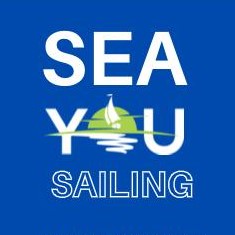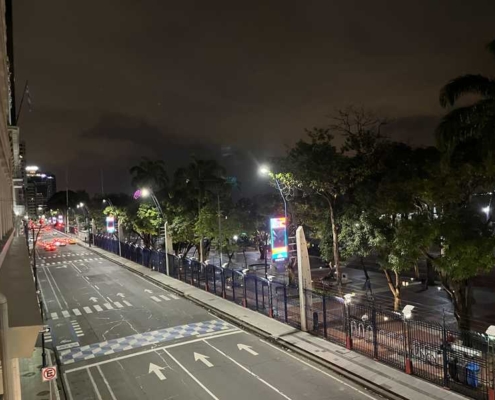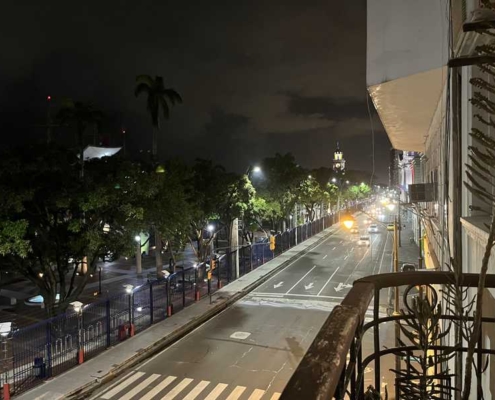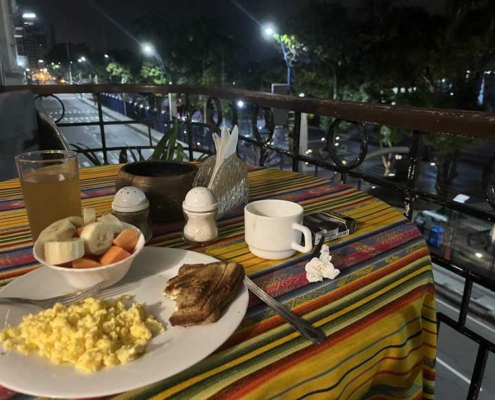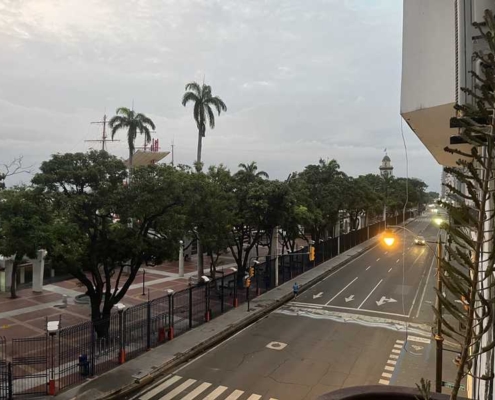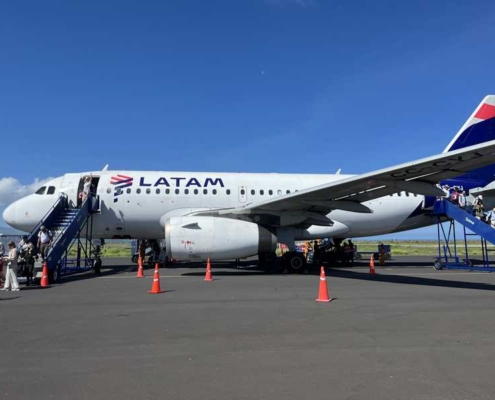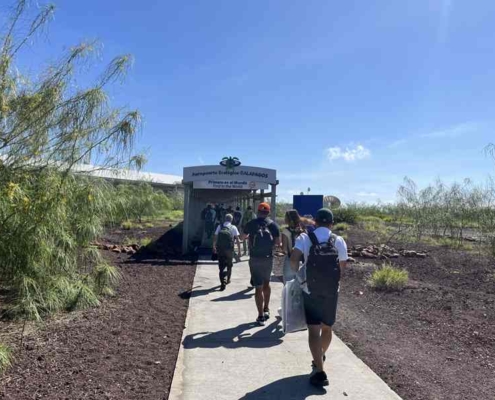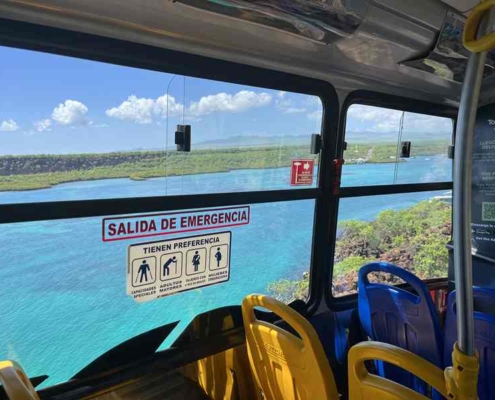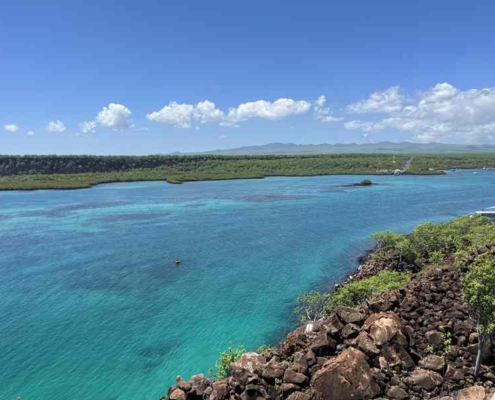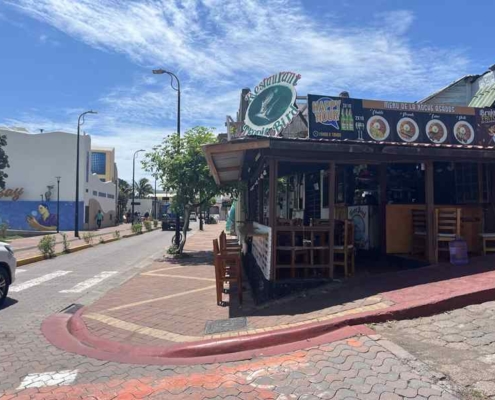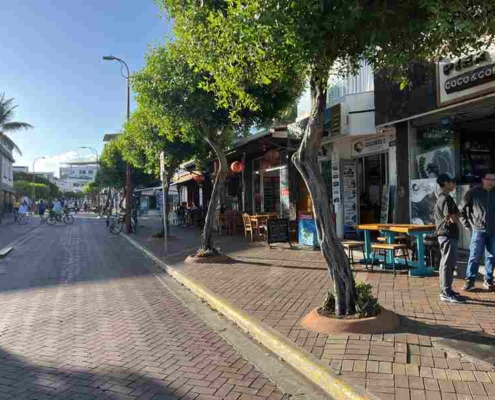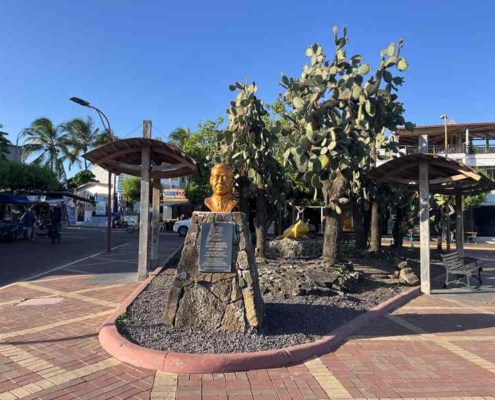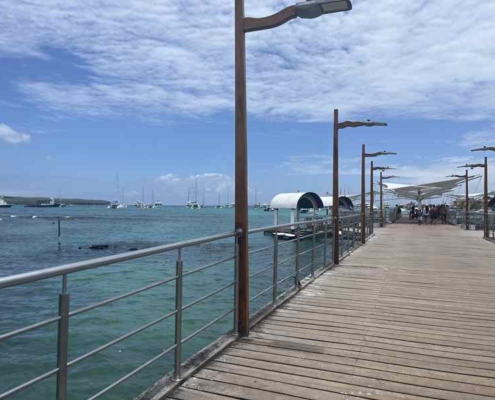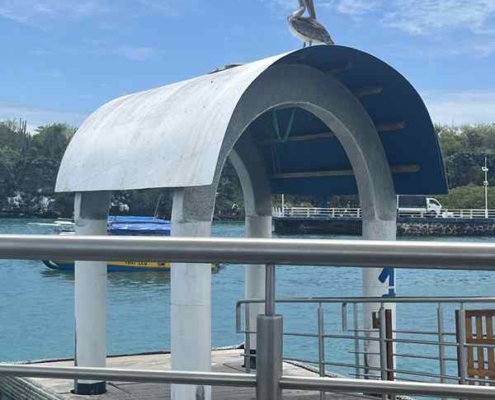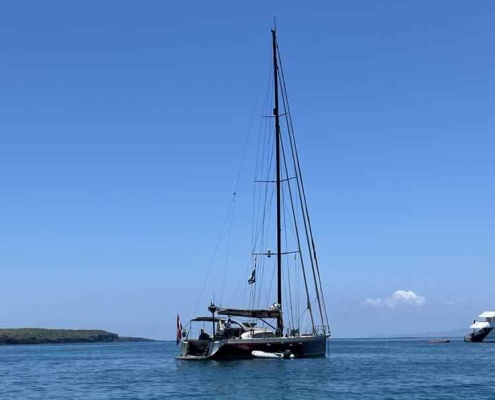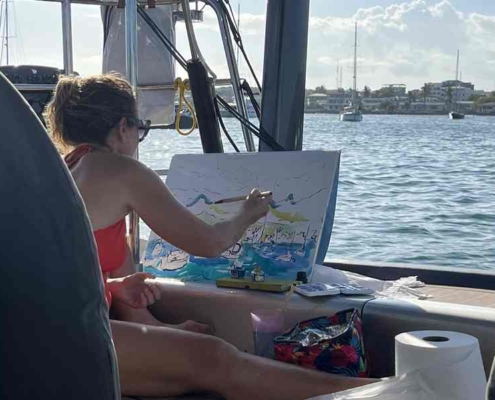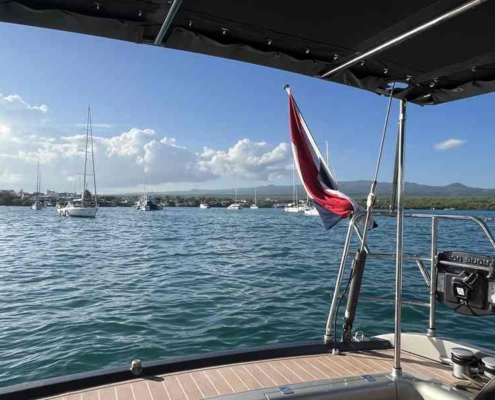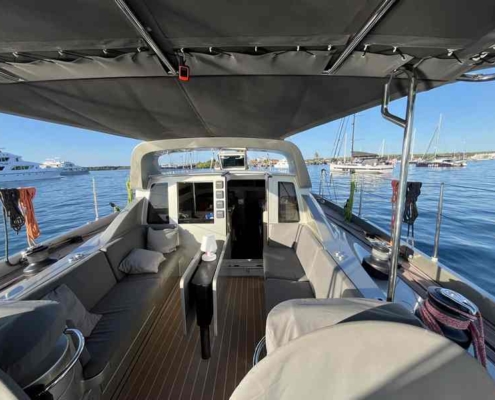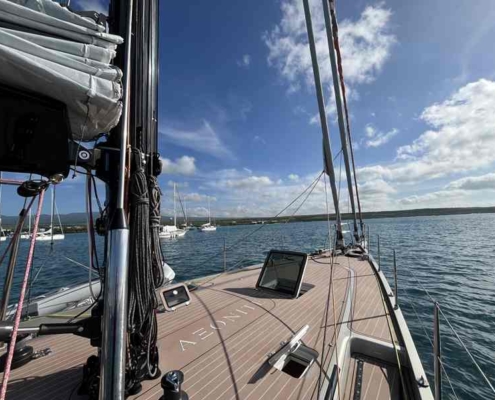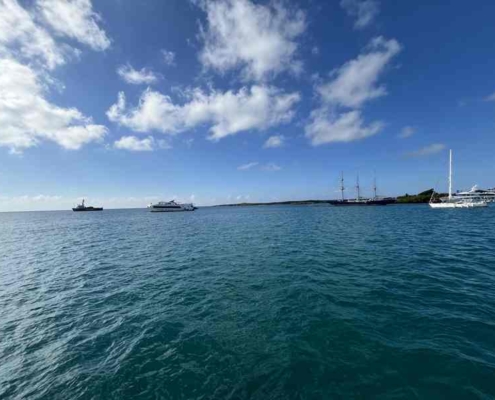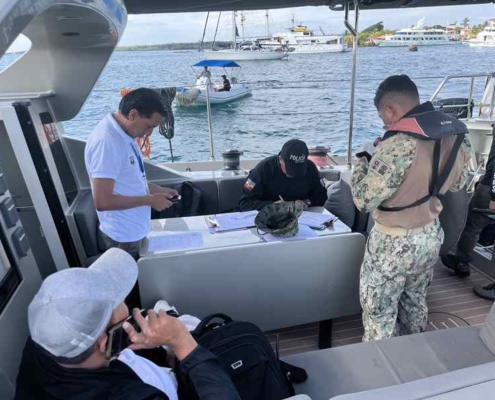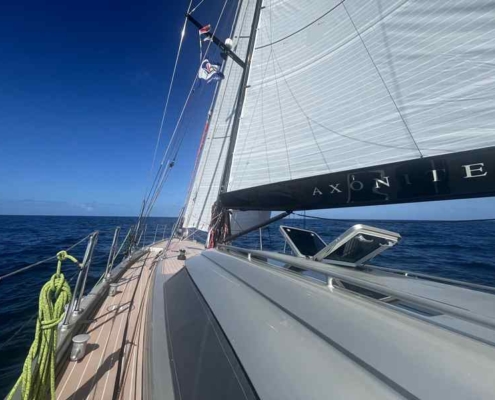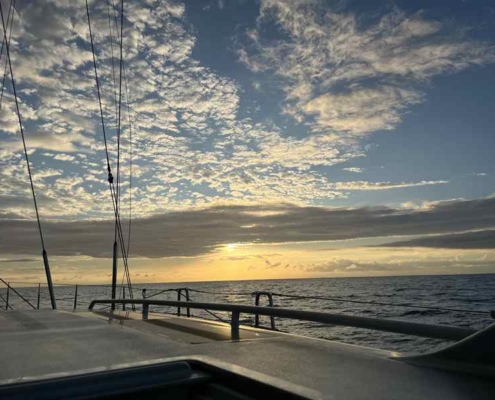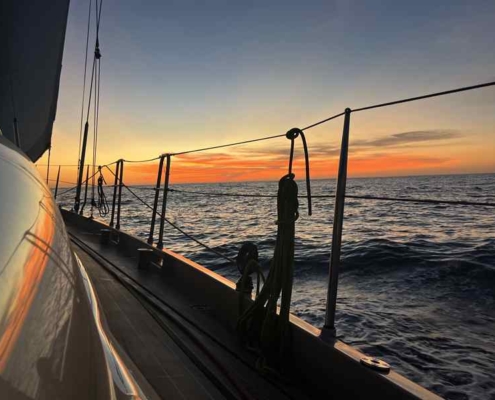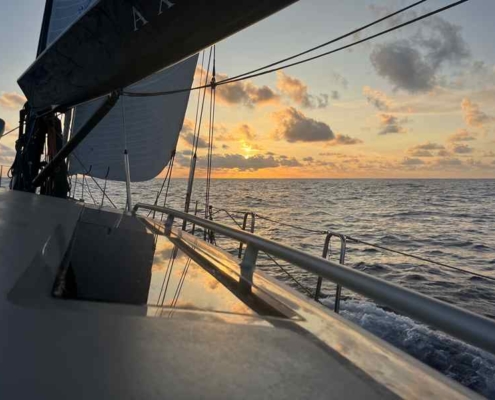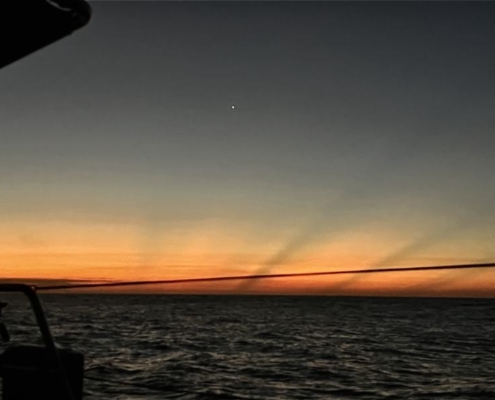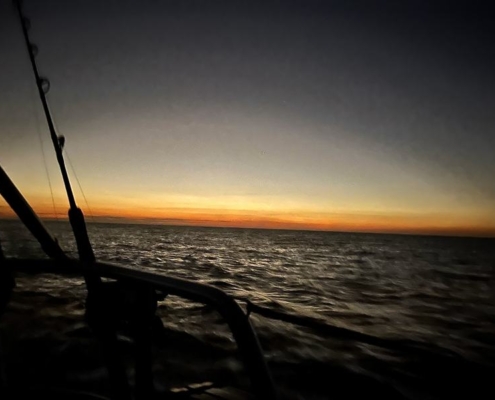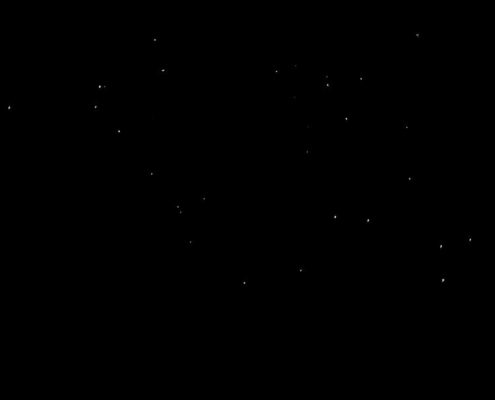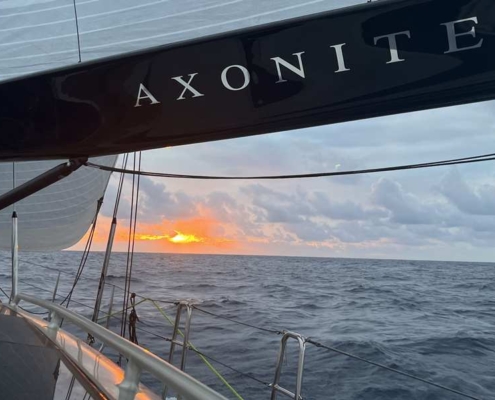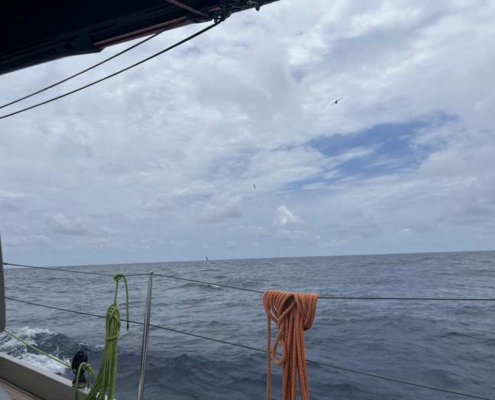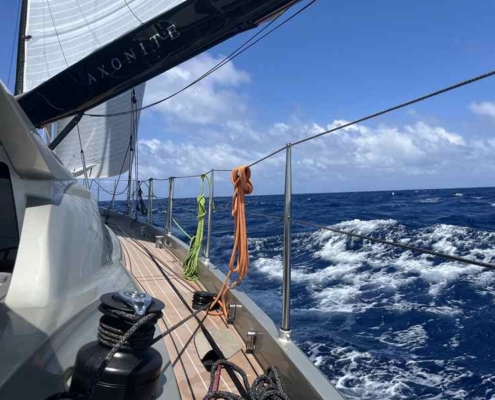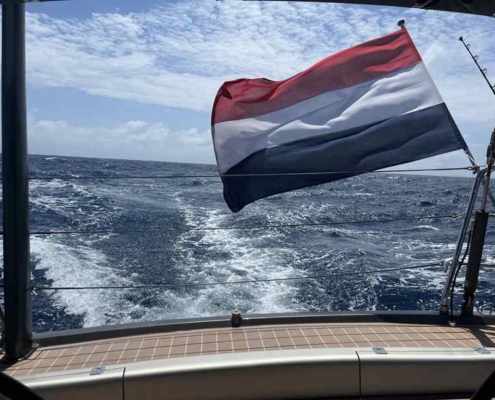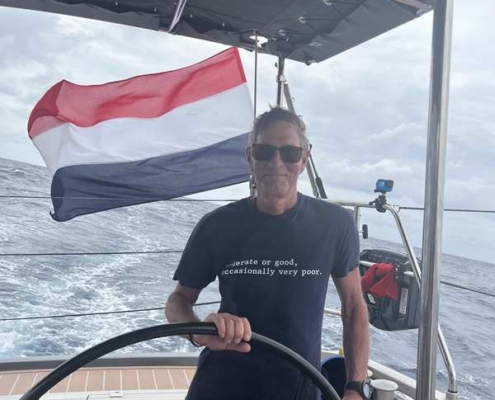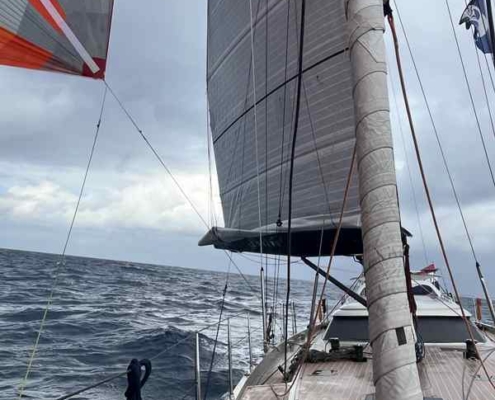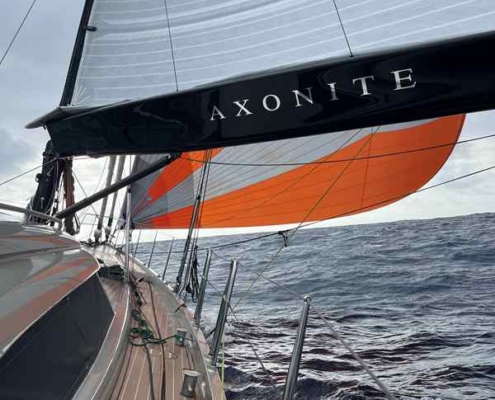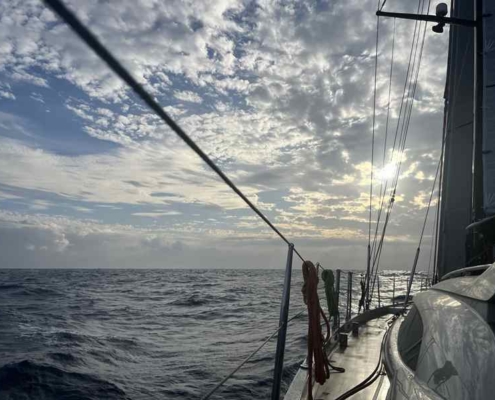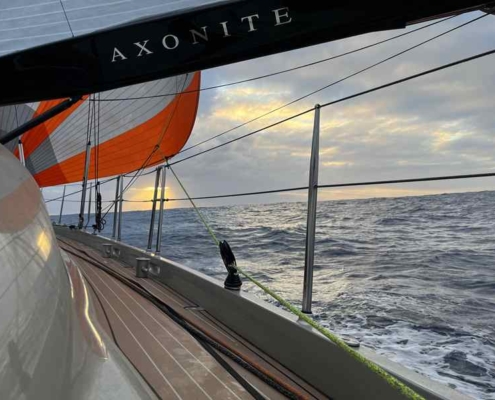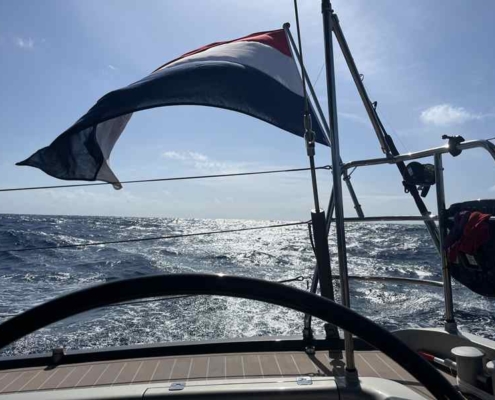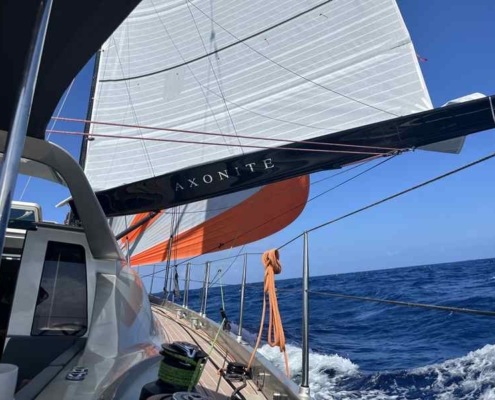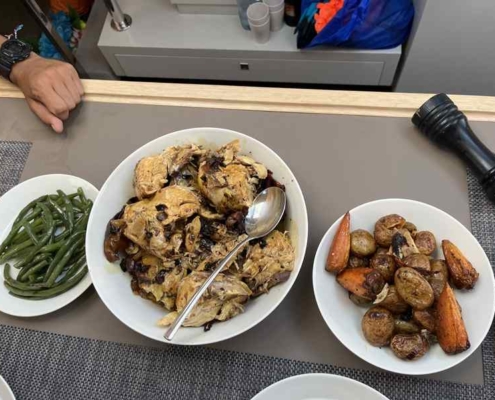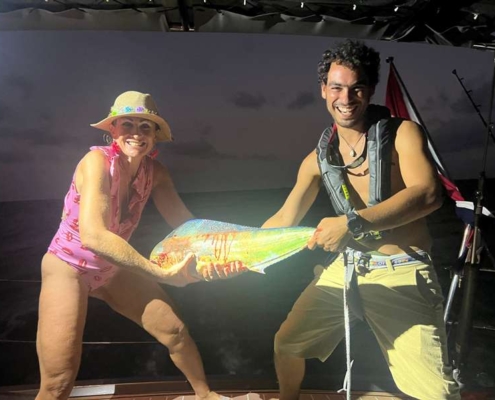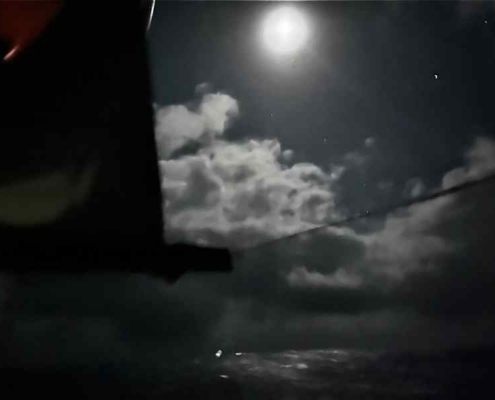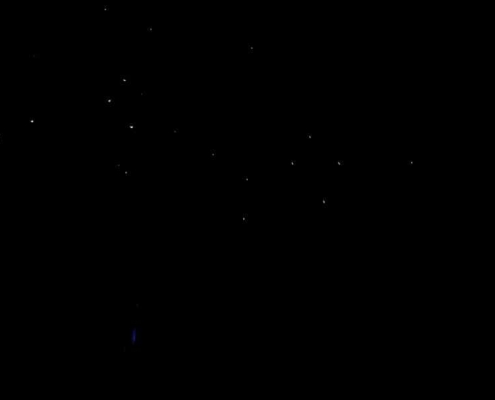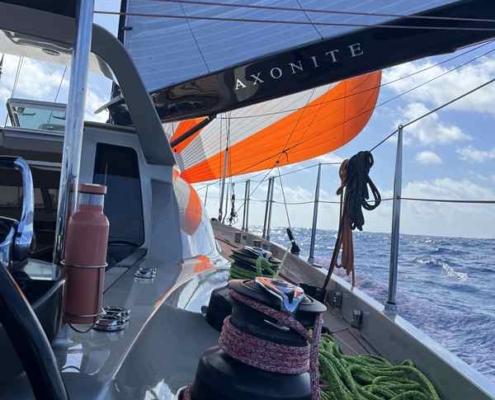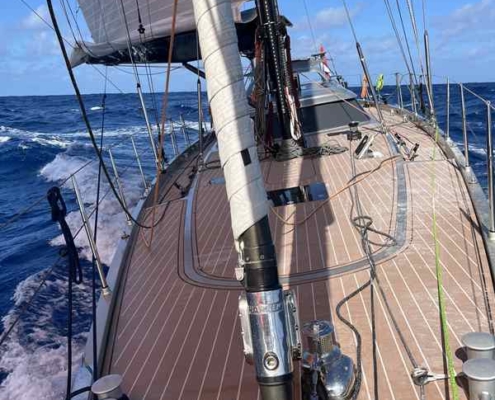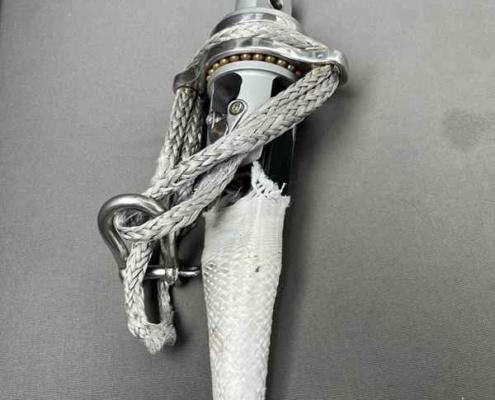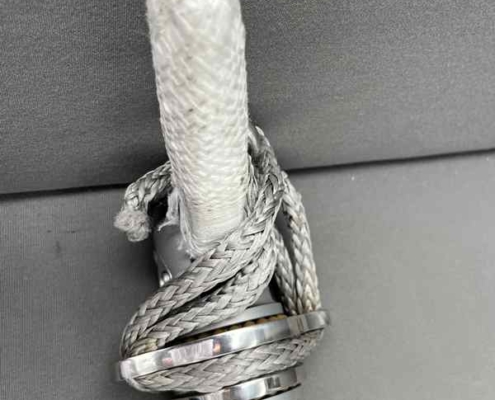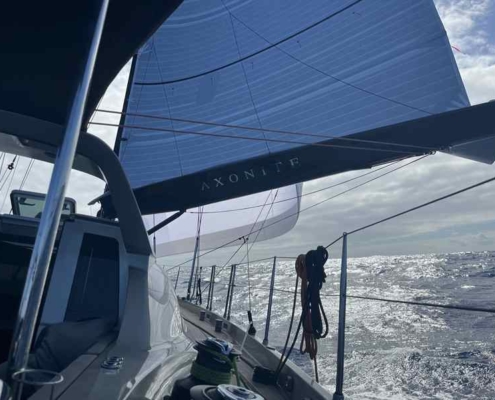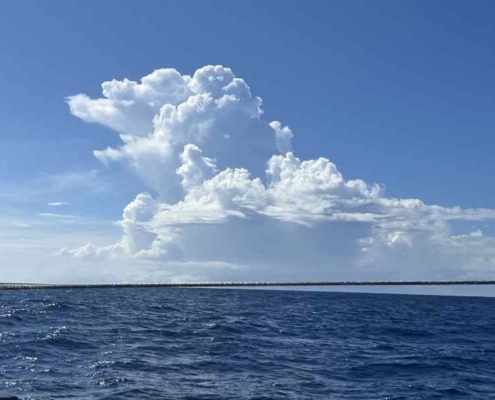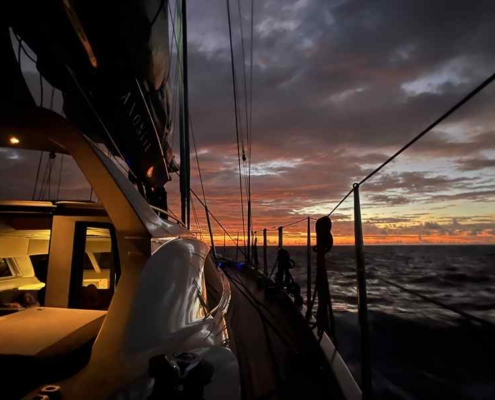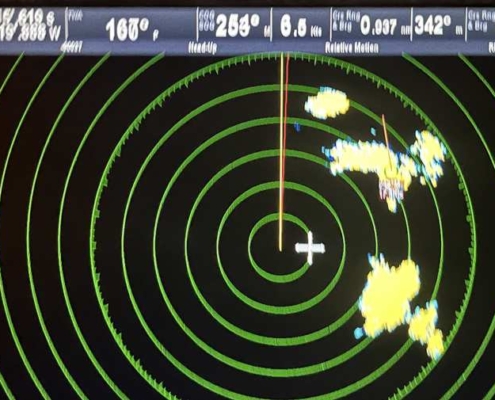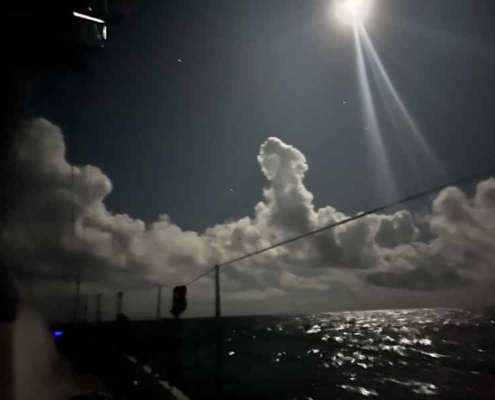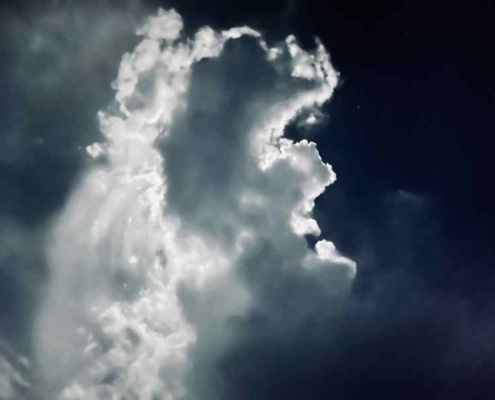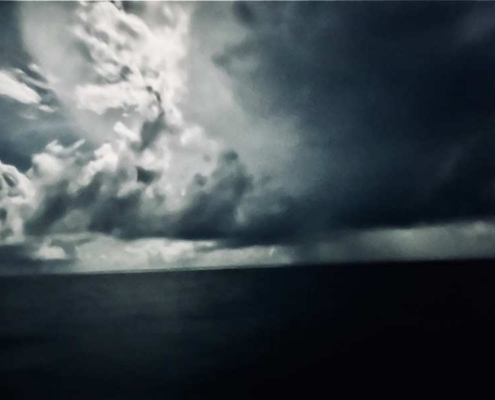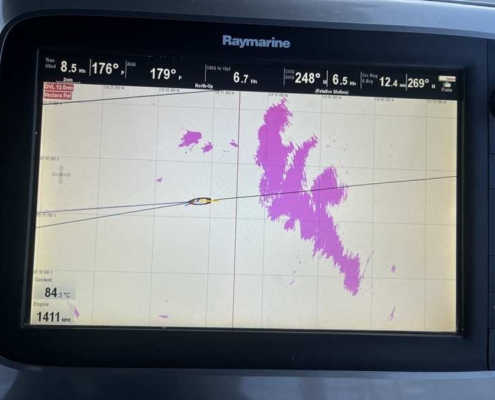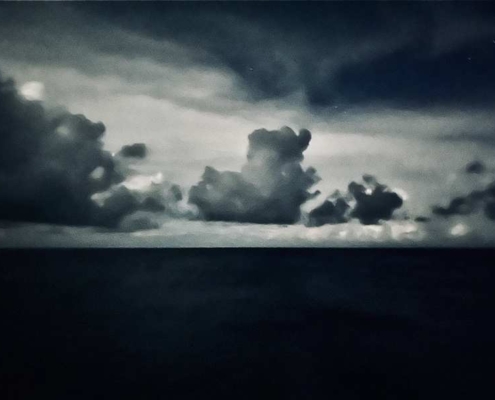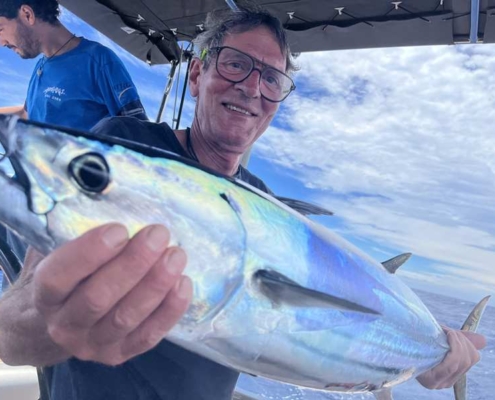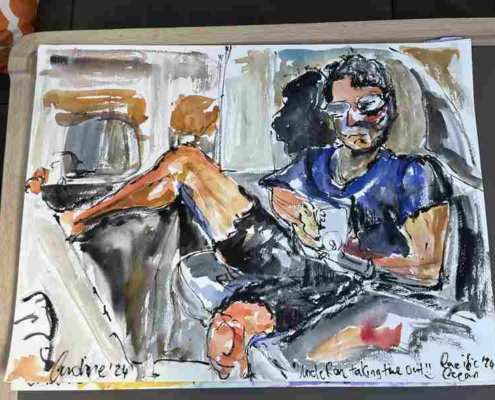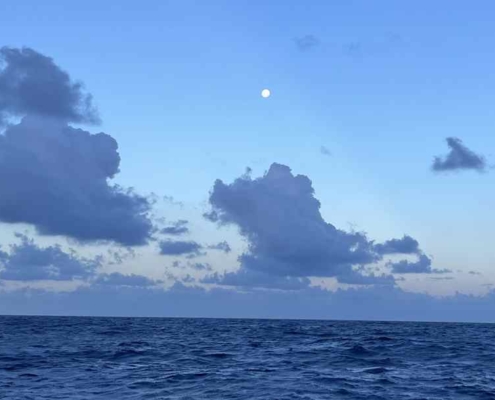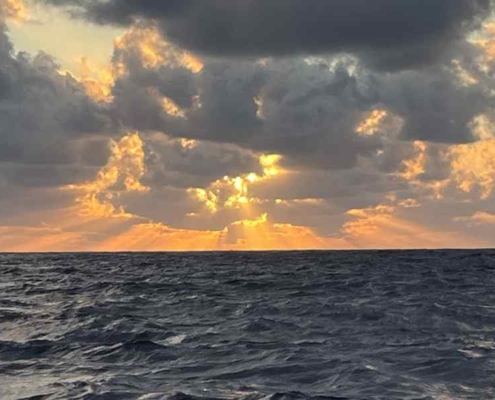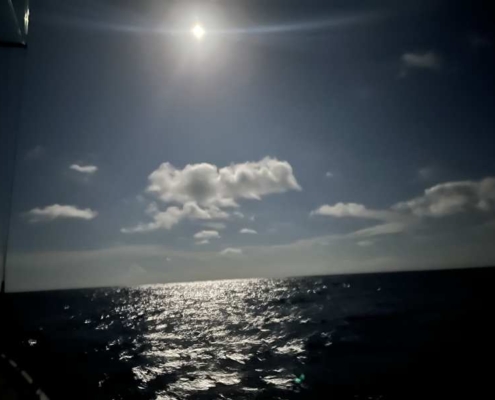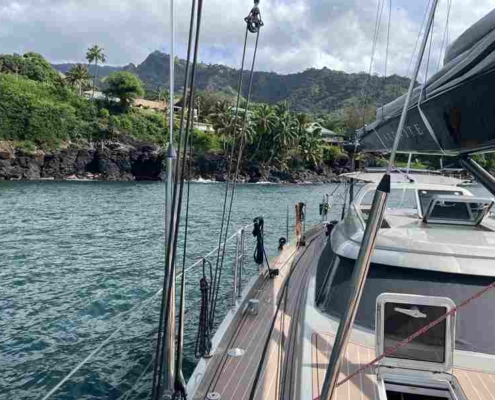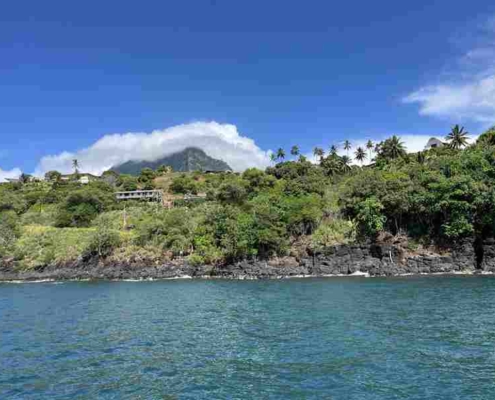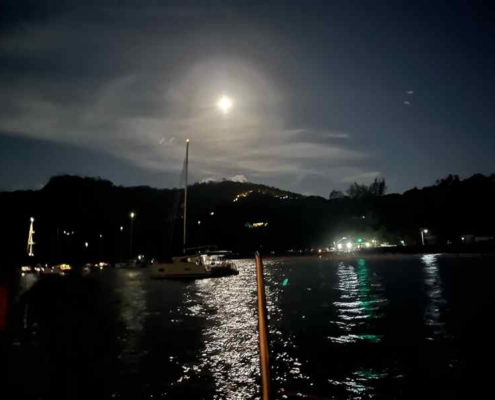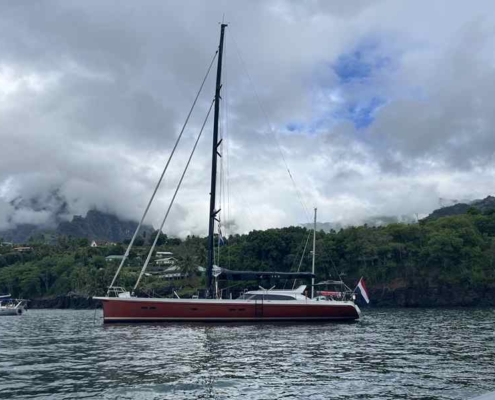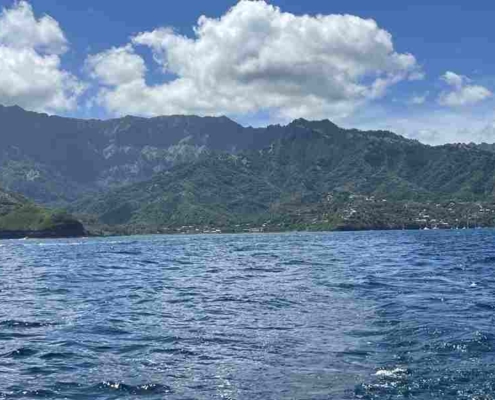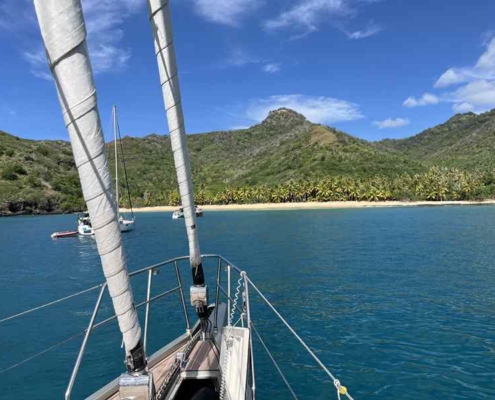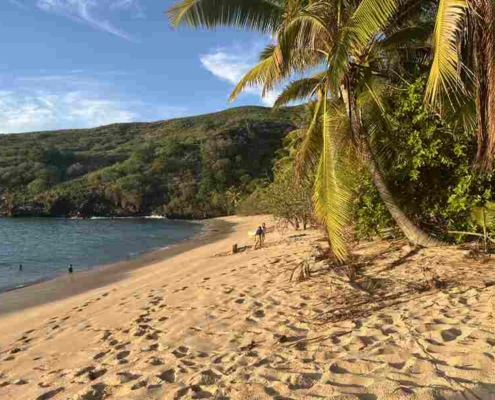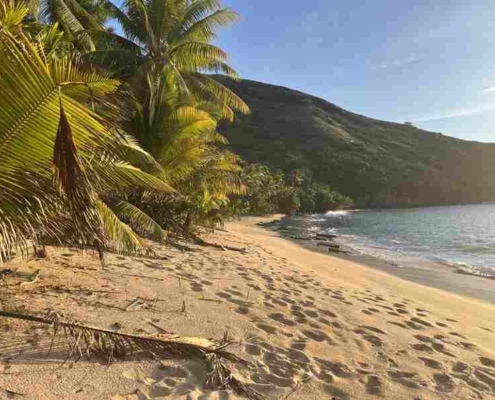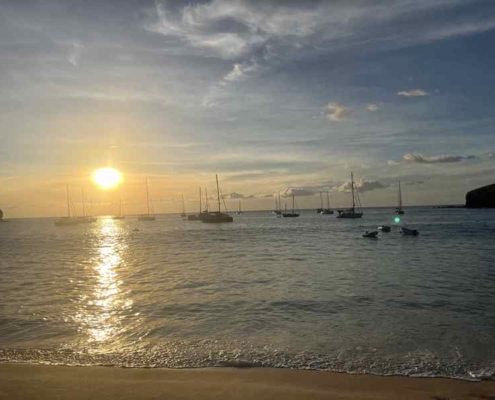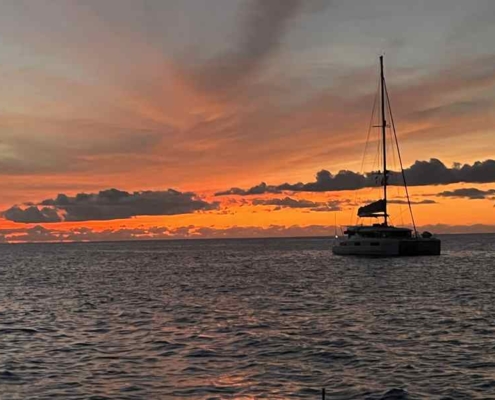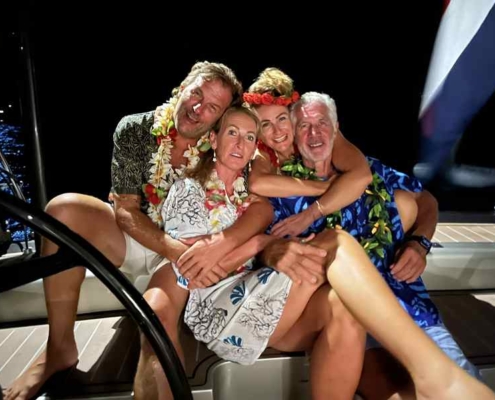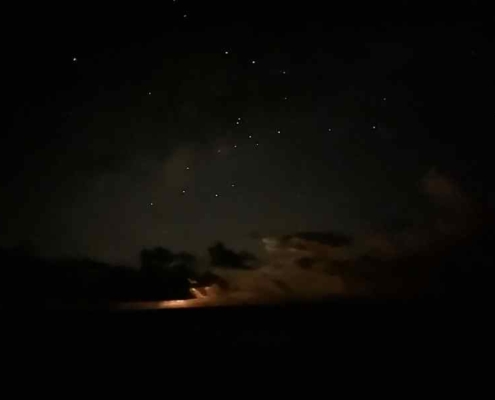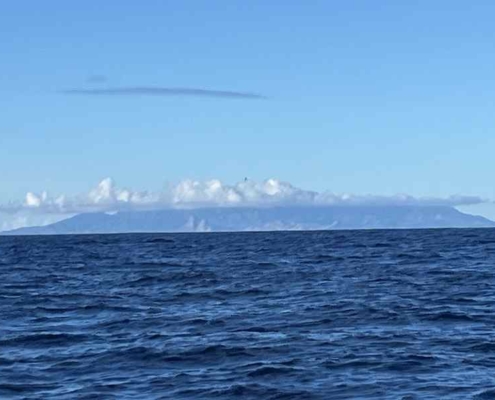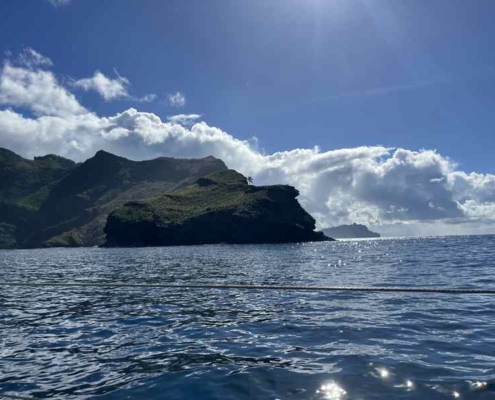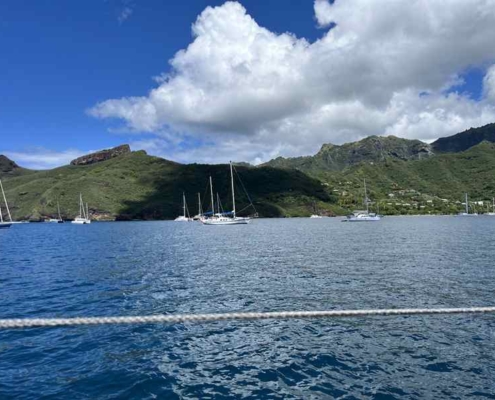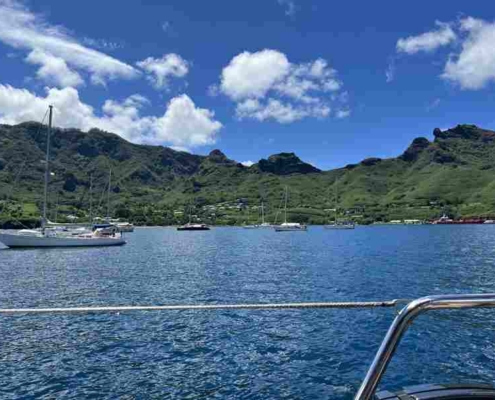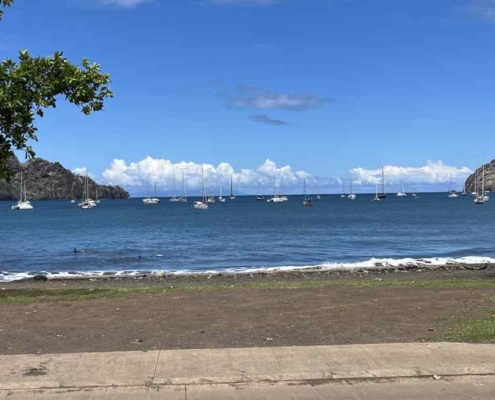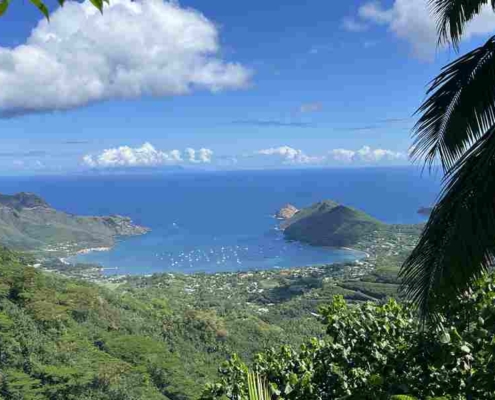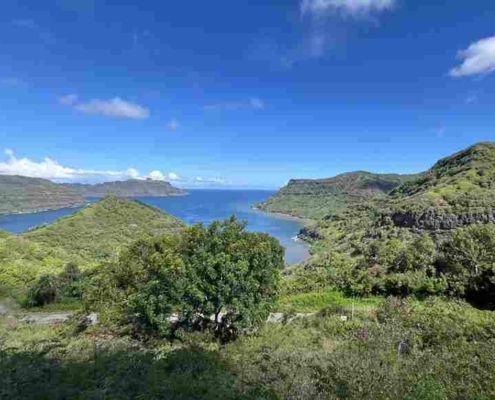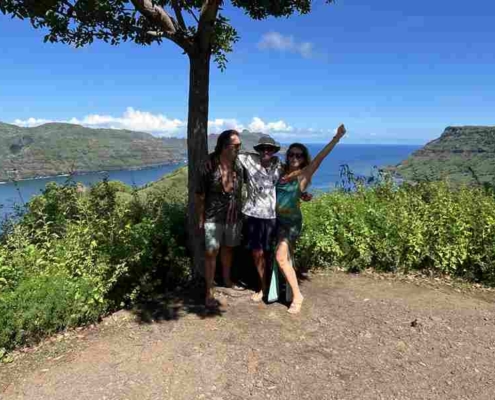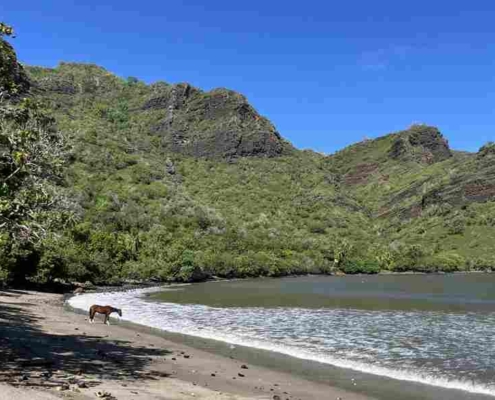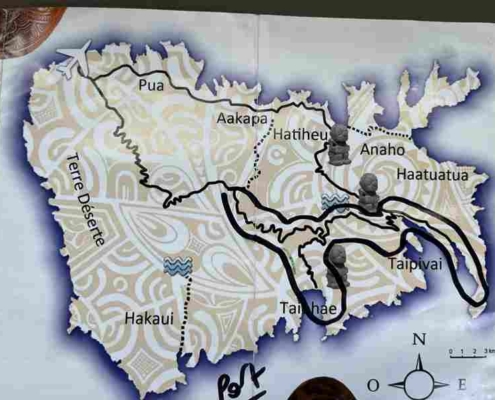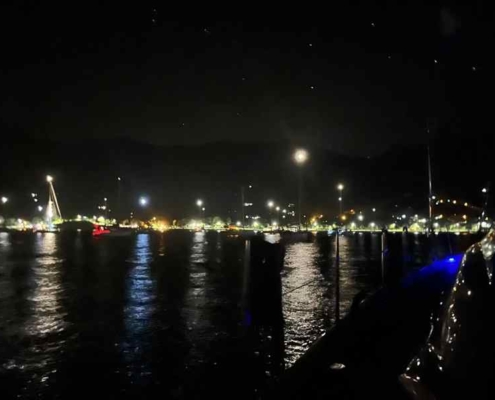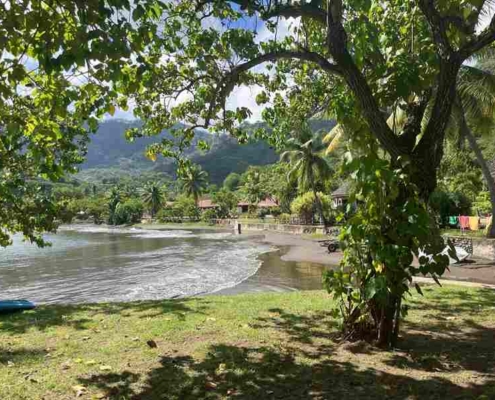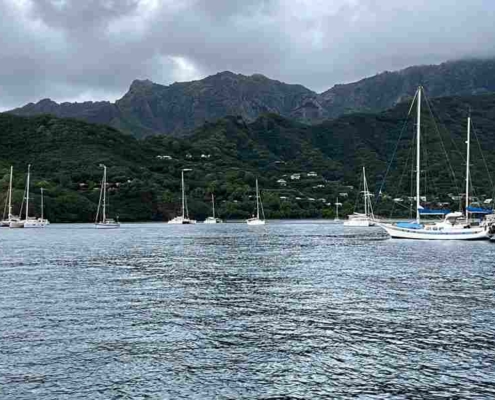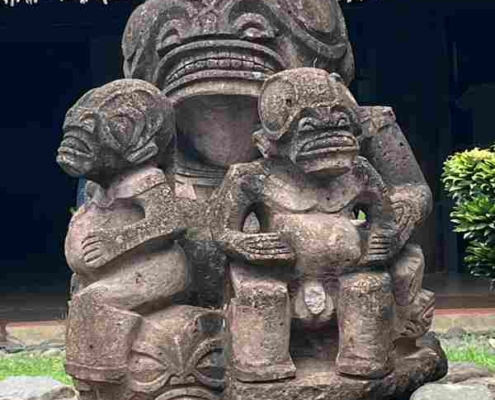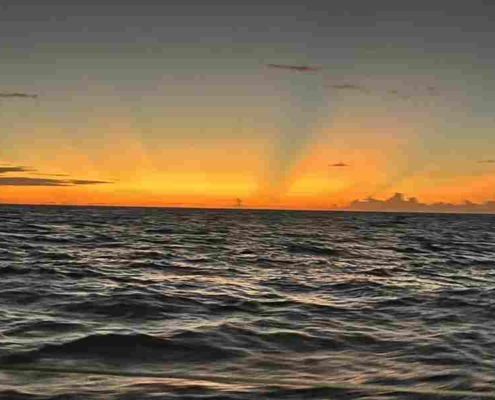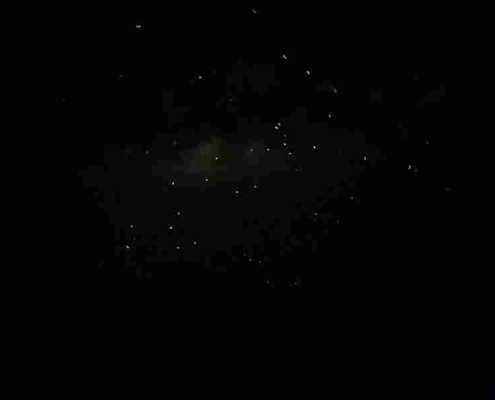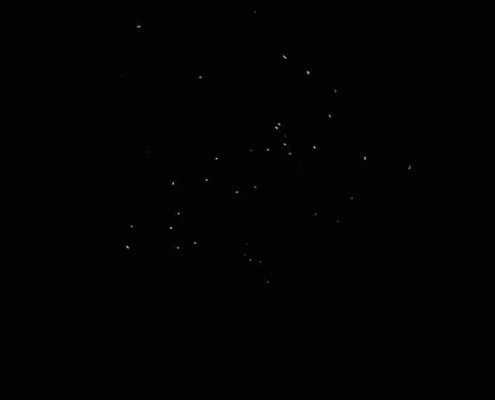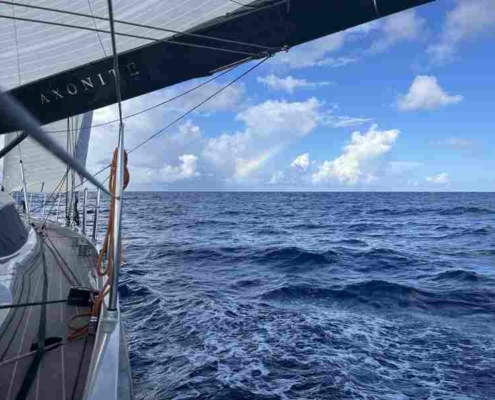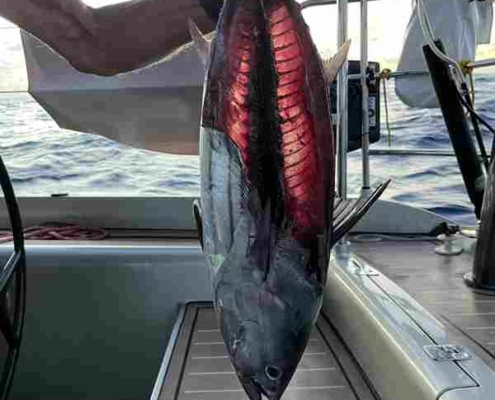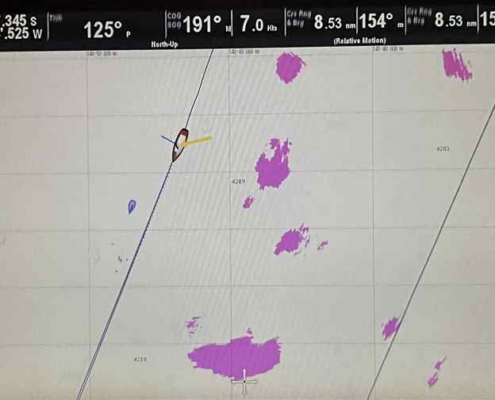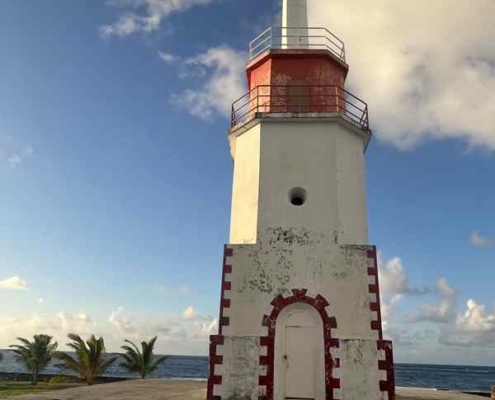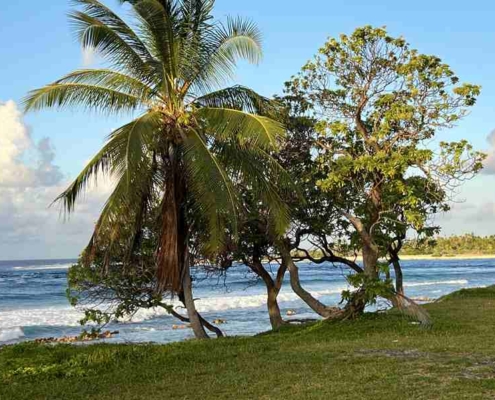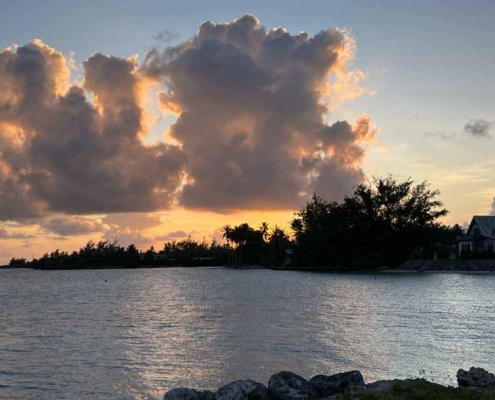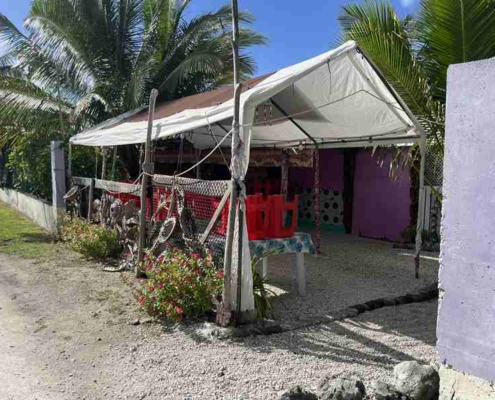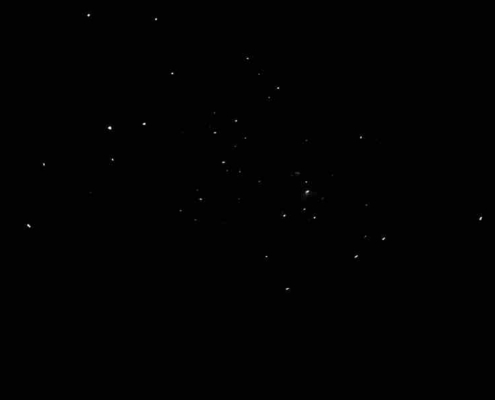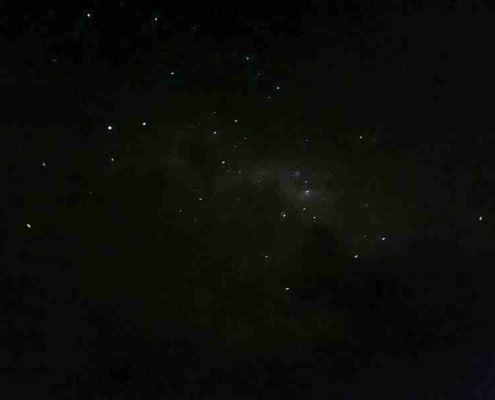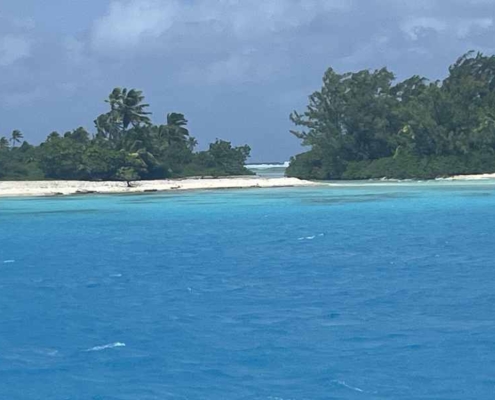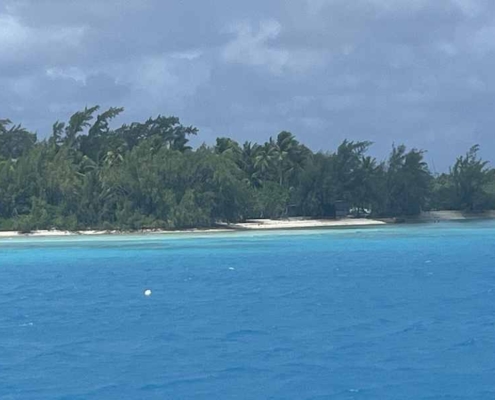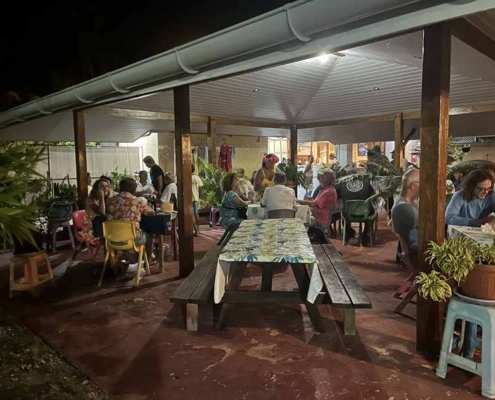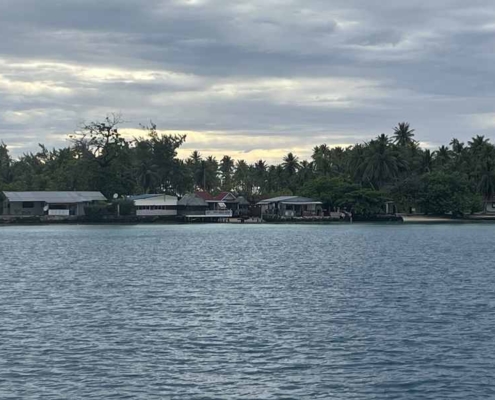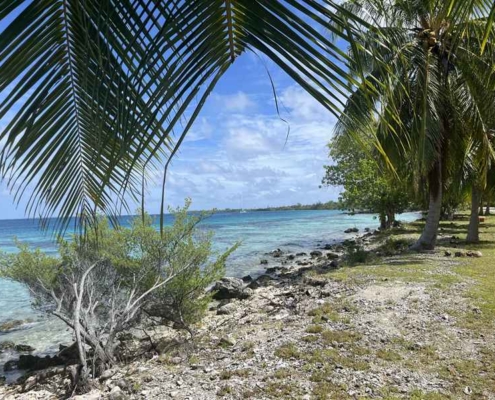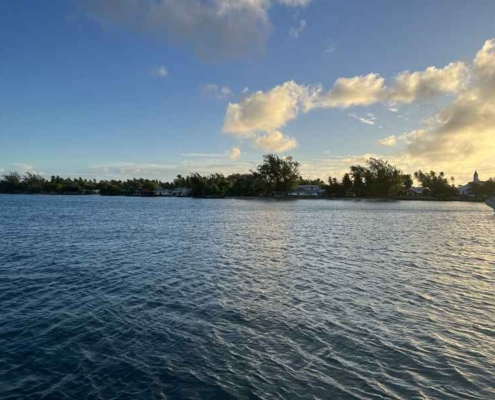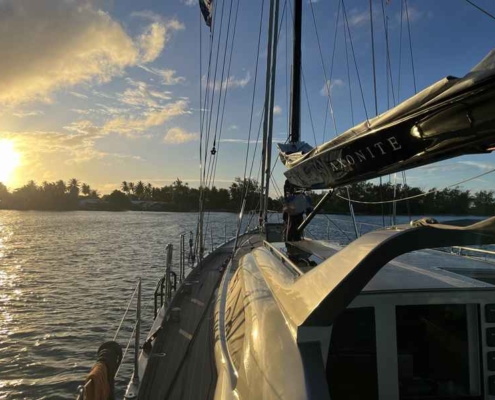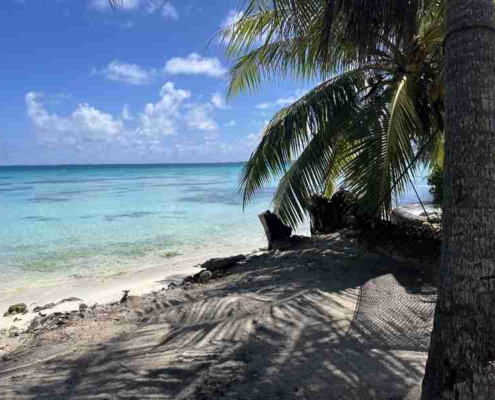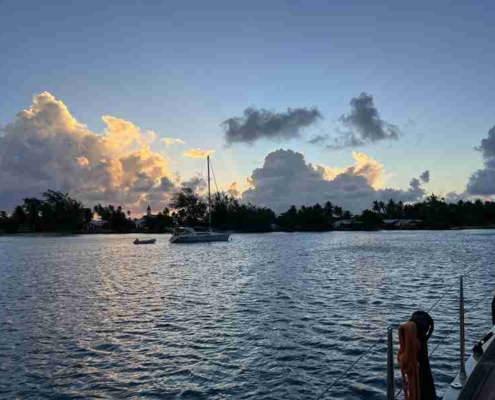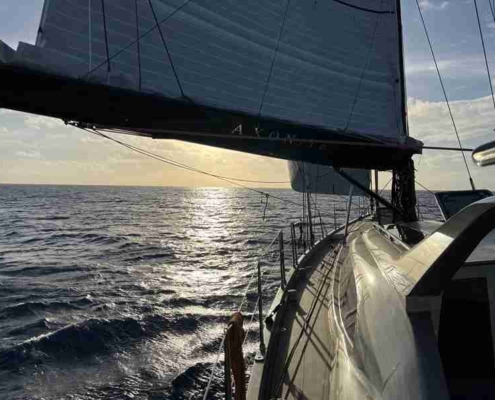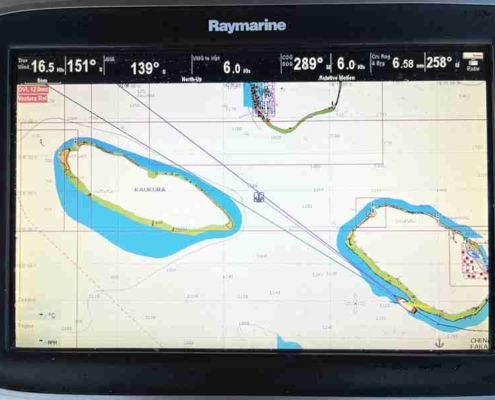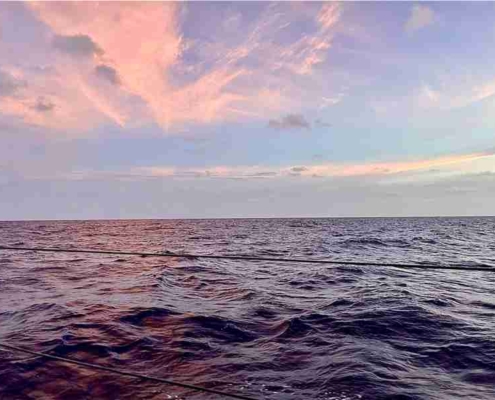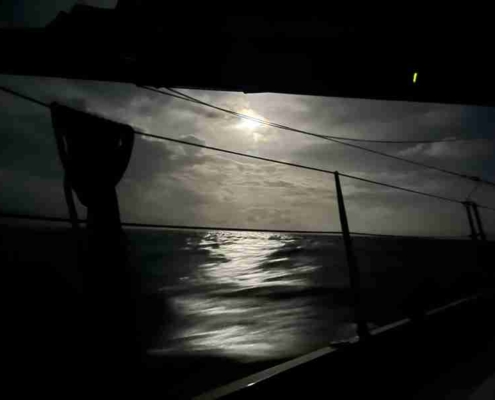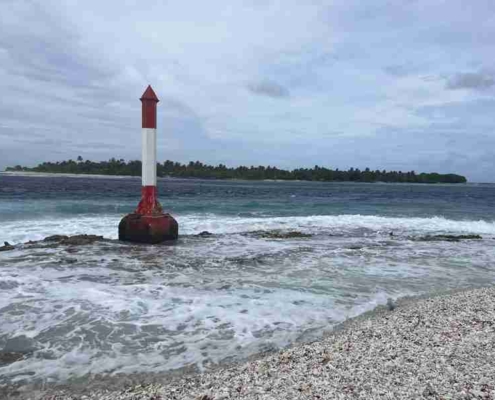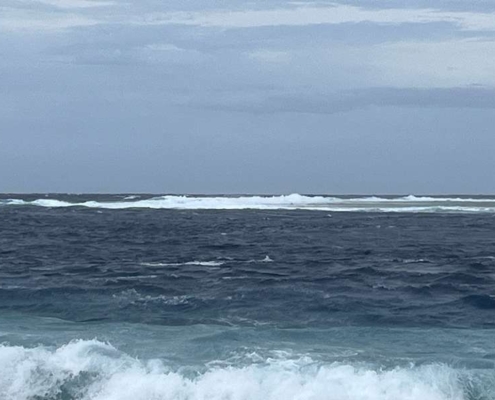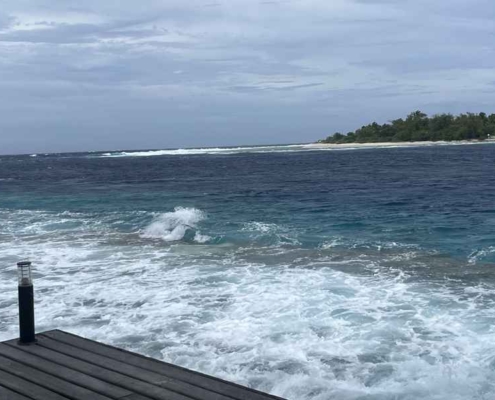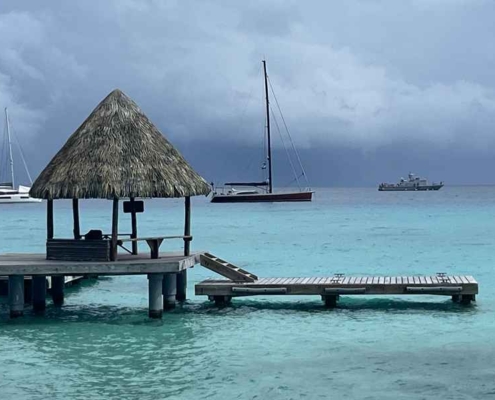Click here to add your own text
Axonite, custom buld 69; Galapagos – Rangiroa French Polynesia, March – May 2024
March 1st, departure to Santa Cruz, Galápagos
The plan was a direct flight to Guayaquil, but in the end I made a stopover in Quito. Not the worst thing after 12 hours on a plane—it was actually nice to stretch my legs. Everyone had to disembark, though.
We had to take all our carry-on luggage with us, which was less ideal since it turned out to be nearly a kilometer-long walk. Then, back through security again. Not sure what the logic was behind that… Of course, they wanted to open my bag—apparently my wire stripper looked suspicious. Anyway, once through security, it was all the way back again. At least we could board right away.
When I arrived in Guayaquil, I decided to double-check if my checked luggage might show up on the belt after all. At Schiphol they had told me it would be checked through…
You guessed it—there it was. So now I was stuck hauling nearly 50kg of luggage: my own bag and about 25kg of gear Marc had sent to me in advance. Oh, and the taxi driver definitely expected a tip.
My connecting flight to Baltra wasn’t until the next morning, so I’d booked an airbnb for the night. Great decision! Super friendly people and excellent service. The only downside was four flights of stairs… with all that luggage, of course. But even that wasn’t a problem—they helped me carry it up.
And believe it or not, within ten minutes of checking in, another courier showed up with yet another package Marc had ordered. Luckily, I could still fit it in my bag.
Tuesday March 5th, Santa Cruz
Getting to Santa Cruz was a bit of an operation, but everything went smoothly. I was up at 5:00 AM, and my airbnb had arranged both a ride to the airport and even breakfast for me at 6:00.
To fly to the Galápagos, you first have to buy an entrance pass for $20. Then, when you land in Baltra, you also need to pay a $100 entrance fee—cash only. I only had $40, and the ATM wasn’t working…
Luckily, Marc and Caroline were there to pick me up, and Marc had enough cash so I could get my passport back.
From the airport, we took a shuttle to the ferry, which brought us to Santa Cruz. From there, a 40-minute taxi ride got us to the marina, and finally a water taxi to the boat. Phew… I was pretty exhausted by then.
The next few days were a mix of meeting a lot of new people and tackling a long list of boat projects. It was a good thing I did all my island tours last year!
Axonite is an incredible boat—beautifully maintained—but like on any boat, there’s always “the list.” Marc is as detail-oriented as I am, which meant things took time. On Monday, we spent all morning in the engine room fixing a small leak in the watermaker.
The next day we did all the departure checklist items together—also in the engine room. A lot of work, but a great way to get to know each other.
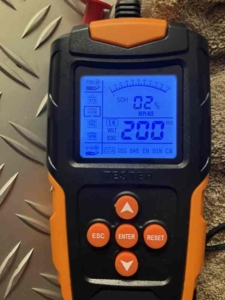 One hiccup: while Marc was explaining the onboard systems, we noticed the starter battery was charging at 20 amps—which was way too high for a supposedly full battery.
One hiccup: while Marc was explaining the onboard systems, we noticed the starter battery was charging at 20 amps—which was way too high for a supposedly full battery.
Good thing I’d brought my battery tester. Turns out the internal resistance was way too high and the battery couldn’t hold a charge anymore. So it had to be replaced.
Thursday March 7th, delayed departure to Hiva Oa
We were meant to leave on Wednesday, but replacing the starter battery took an entire day—and brought us nowhere.
You’d think it wouldn’t be so hard to find a car battery on an island where cars are everywhere. But size and specs mattered, and we needed something that could deliver about 1000Ah—Axonite has a pretty beefy 6-cylinder diesel.
The first battery Miguel brought tested poorly—probably been sitting on a shelf too long. The engine wouldn’t even turn over.
The second one wasn’t strong enough either. Meanwhile, Marc ran a reconditioning program on the original battery—and surprisingly, it came back to life. We reinstalled it, and everything worked perfectly again.
So yeah, we lost a whole day. But maybe for a reason, because that evening the water pump failed—no shower, no tap water, no flushing toilet. We were able to swap in the backup pump fairly easily, but definitely better to fix that at anchor than at sea.
Friday March 8th, position: 01°19.381S 092°05.562W
At 08:30, the authorities came aboard for check-out. This time, five officials—each with their own form that all had to be signed also by the other four. Still, everything went fine, and we were officially cleared.
One last thing: we needed to get a spare water pump before setting off.
By the end of the first 24 hours, we’d sailed 199Nm, thanks in part to favorable current. Not bad at all. Even better: we caught a beautiful tuna just a few hours in—dinner sorted!
We crossed off some more to-dos: splicing a new shackle on the main halyard, redoing a few other small things. The rhythm onboard came surprisingly naturally. Everything is laid out logically on Axonite, and my previous experience on boats helped a lot.
Still, some things were new to me—like the digital switching system. I’d just read about that in the advanced electrical course before coming aboard, so seeing it in action was a great learning experience.
Every day is a school day!
Sunday March 10th, position: 04°38.018S 099°09.134W
We’re three days in now, and everything’s going great! The vibe on board is awesome, and we’re really enjoying this Pacific crossing. Hardly any swell, 10–15 knots of wind, and we’re averaging around 8.5 knots SOG.
So far, we’ve covered 570 nautical miles—about 190 a day. If the forecast is right, the wind should pick up a bit over the next few days. That’ll let us sail a bit deeper downwind, and with the gennaker up, we should be able to hit around 12 knots SOG.
We’ll probably start overtaking the tail end of the fleet tomorrow or so.
Fishing’s been going really well too. We’ve caught five tuna so far! We did throw one back because it was a bit small. Apart from the first one, none have really been photo-worthy… but they still taste amazing!
Axonite is such a beautiful boat! She’s got two ballast tanks too, which makes things super comfy. We’ve mostly been sailing on a beam reach so far. When the wind picks up, we just fill the ballast tanks a bit and the heel is hardly noticeable.
With the lifting keel down, we draw over 3.5 meters, which makes for a really stable ride.
The weather’s been lovely so far—sunny with some clouds here and there. The breeze keeps things from getting too hot. No rain yet, and no squalls either.
Tuesday, March 12 – position: 05°34.778’S, 107°04.037’W
Today we set the clock back an hour.
The past few days have been mostly cloudy—some sunshine here and there, and the occasional bit of rain. Not enough to rinse the boat off, but just enough to keep the hatches in the saloon closed. So yep, it’s been hot.
I cooked yesterday, which felt like a bit of a challenge since Caroline is a real chef. I wouldn’t dare compare my kitchen skills to hers, but luckily it turned out pretty tasty. She was happy to have someone else take over for a change. She normally does all the cooking—twice a day, lunch and dinner—and she does it really well. But cooking in this heat, at this latitude… whew, it’s tough.
Fishing hasn’t been going our way the past couple of days. We had two bites, both so wild that the line snapped almost instantly. And the other line came back empty—no fish and three lures gone. Oh well… thankfully Marc managed to grab a few extras back in Santa Cruz.
Meanwhile, we’re flying—right on the rhumb line. Yesterday afternoon we sailed with the gennaker for the first time, right up until sunset. We’re not quite at the point of flying it overnight just yet.
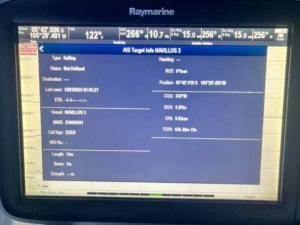
 By the end of last night, we’d already passed five boats, and early this morning I saw Navillus III pop up on the AIS. Game on.
By the end of last night, we’d already passed five boats, and early this morning I saw Navillus III pop up on the AIS. Game on.
Right around the time we passed them, we hit the 1000 Nm mark. 1000 nautical miles in 112 hours—not even five days. That’s the fastest I’ve ever done that distance. If we can keep this up, we’ll be there in 15 days!
Well, we’ll see how it goes. For now, we’re averaging a solid 10 knots SOG today.
Thursday March 14th, position: 05°57.109’S, 117°23.307’W half way
Yesterday was a pretty cloudy day with some light drizzle now and then, but by late afternoon the skies started to clear up a bit.
We also switched up the watch schedule—I’m now on the midnight to 4 AM shift. When I came on watch last night, the sky had cleared completely and the stars were absolutely stunning again.
Today was a special one—we hit the halfway mark!
It took us exactly 7 days to cover the first 1,500 nautical miles. If we hadn’t turned the clock back, we’d have hit it to the hour. Compared to last year, that’s super fast—we did the whole passage in 22 days back then. We’re not there yet, of course, but the forecast looks good, and if we can hold this course and speed, we might shave a whole week off!
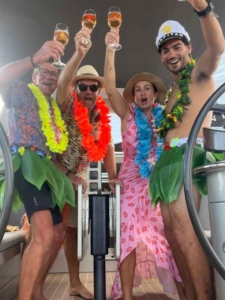 I’d picked up a little bottle of champagne back in Santa Cruz just for this moment—and yep, we popped it! Fully dressed up in equator crossing gear, of course.
I’d picked up a little bottle of champagne back in Santa Cruz just for this moment—and yep, we popped it! Fully dressed up in equator crossing gear, of course.
Caroline roasted a chicken in the oven and put together a proper celebratory dinner.
Honestly, I’ve never had such a festive halfway party at sea before. The vibe on board is just amazing!
We’d been flying the gennaker all day, but then Marc noticed the furler on the bowsprit was starting to come loose—not great. We woke Miguel and the three of us sorted it out: tightened it up as best we could, furled the sail, dropped it, took off the furler, cleaned it up, and reattached it with Loctite.
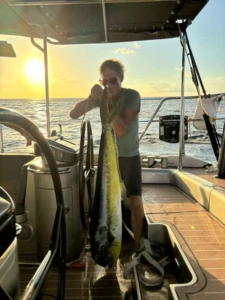 Just as we were getting ready to head back up to the foredeck—fish on! It put up a little fight, but we landed a beautiful mahi mahi. Dinner secured!
Just as we were getting ready to head back up to the foredeck—fish on! It put up a little fight, but we landed a beautiful mahi mahi. Dinner secured!
By then it was too dark to hoist the gennaker again. The wind had picked up a bit anyway, so we lashed everything down on deck and set the genoa. It’s a bit slower, sure, but hey—we’re not racing.
Saturday March 16th, position: 07°09.653’S, 122°10.092’W, drama at sea
Yesterday morning we hoisted the gennaker again—a beautiful sail that gives us a solid 10 knots SOG on this course. The wind eased a little during the day, and we decided to leave the gennaker up overnight for the first time. It went totally fine, and by the end of the day we had climbed three more spots in the fleet!
Today was just one of those perfect sailing days—nice breeze, not too much swell, and that classic Pacific sky. The only thing that got a bit annoying was our unexpected stowaway: a booby bird that apparently also decided to cross the ocean, and kept napping on the pulpit. Of course, it also kept crapping all over the bowsprit. We tried scaring it off, but it just circled around and came straight back every time. Eventually we gave up. Regular cleanups it is.
After dinner, suddenly the boat heeled sharply. Within seconds, we were in the cockpit. The autopilot had disengaged, and we’d crash-gybed!
The gennaker went wild, and the mainsail was caught by the preventer. I got us back on course with the engine, but the autopilot was dead.
Turns out the gennaker had torn, and the torsion line was broken too. We furled it as best we could, got it down, and secured it on deck. Marc switched to the backup autopilot—thankfully it worked.
Once everything was under control again, we cleaned up the galley mess (everything had hit the floor during the heel).
Just goes to show—one minute everything’s smooth sailing, the next you’re dealing with a full-blown situation.
Monday, March 18th, position: 08°41.666S 127°54.775W
What was left of the night passed quietly.
The next morning, out of nowhere, the backup autopilot started acting up. The heading went completely haywire—spinning in 360s and sending the boat all over the place. Luckily, I was right at the helm and could switch it to standby immediately. Tried a reset and gave it another go. It lasted maybe five minutes before it started spinning again.
Meanwhile, we figured out the issue with the original autopilot—turned out to be a blown fuse. Miguel dove into the lazarette to check it and, yep: blown. It was just a 5A fuse, though we weren’t entirely sure what it actually did. The other autopilot had a 10A fuse, so we popped one of those in instead. Problem solved! Autopilot was back in action.
But then the question: why had the backup gone crazy?
We decided to hoist the spare gennaker, which went smoothly and got us back up to speed.
Once everything was up and running again, our feathered friend reclaimed his spot on the pulpit. We’ve stopped trying to chase him off. He now has a name: Billy the Booby. Of course, that also means deck-cleaning duty every morning.
We kept wondering what had triggered the backup autopilot issue. Eventually, we tracked it down to the flux compass. We started digging around… and surprise! There was a spare part lying in the same locker—with a strong magnet! Once we removed that, the backup autopilot worked perfectly again. Another mystery solved.
The rest of the day was smooth sailing—great weather, great wind, and full speed toward Hiva Oa.
We even decided to keep the gennaker up overnight. That went fine until Miguel woke me up to be on standby for a squall.
I had just gotten on deck when the wind kicked in—28 knots with gusts. Not exactly gennaker furling weather…
We bore off as much as we could without overdoing it, and the autopilot held just fine. It was a lot of wind, but otherwise manageable. The ballast tank was full, and we were flying. Of course, within minutes both Miguel and I were drenched in rain. Funny thing though—once the rain stopped, my shirt dried out in no time. Until the next squall, anyway…
The wind and rain lasted for about an hour and then eased off. It was still pitch dark. Even though we didn’t see any more rain on radar, there were no stars either. So we decided to furl the gennaker.
Everything seemed to go fine until Miguel noticed the anti-torsion line had snapped—again.
We dropped the sail and secured it on deck. At first, we thought it was due to low halyard tension, but turns out the line had actually snapped at the top, which caused the low tension.
Either way, we’re now down to just the mainsail and the genoa. Which is totally fine, but the wind gradually dropped to classic Pacific levels—12 knots on average. That means we’ll probably need 24–48 hours more to cover the remaining 700Nm to Hiva Oa.
Oh well—might as well use the time to clean the boat. We gained an extra hour today anyway—we set the clocks back again 🙂
Wednesda March 20th, position: 09°09.305S 132°12.155W
Since yesterday morning there’s been too little wind to sail. So, motoring it is. A bit dull—but hey, what can you do?
Well, clean the boat, for one. That’s done now, and it’ll save us time once we arrive. We also reorganized the storage room. That was quite the task in this heat, but super satisfying once it was done.
We’ve got about 400Nm left to go—just over 3 days at our current speed. Hopefully the wind picks up again at some point, although the forecast isn’t very promising.
The weather’s gorgeous though—deep blue skies, puffy clouds on the horizon, and the nights have been stunningly clear. We’ve had moonlight again for a few days now.
Fishing hasn’t been as successful. Twice we had really serious bites—like, big-fish serious. The first one took off with the lure and stripped the reel, even with the drag at max. Snap—gone. The second one wasn’t much different. The line just snapped clean off. Oh well—our freezer probably wasn’t big enough for them anyway.
Friday March 22th, position: 09°33.545S 136°08.600W
Yesterday was a “busy” day—by sailing standards anyway. When I came on deck, the wind had picked up enough to sail. The genoa was already out, and I was just about to wake Miguel so we could raise the mainsail… when we got a bite.
The way the fish tore off with the lure, I knew it was something serious. Luckily, with only the genoa out we weren’t going too fast, and after about 15 minutes we landed a beautiful tuna.
The fight had worn it out completely—it was dead within a few minutes. Since I caught it, I got to do the filleting too. It’s a bit of a job. I prefer to go straight for the fillets rather than gutting the whole fish first—it makes cleanup a lot easier. It takes a bit longer, but it went really well. I think we got over 3 kg of clean tuna fillets.
Thankfully, the freezer had emptied out a bit, so there was plenty of space. Someone once told me that if you want to eat fish as sashimi, you should always freeze it first. That kills off any parasites it might be carrying. They won’t kill you, but they can cause some nasty stomach issues.
Once everything was cleaned up and the deck hosed down, we finally hoisted the mainsail. By that time, we had a solid 20 knots of wind, from a perfect angle. Finally—engine off!
Unfortunately, the wind didn’t last. After lunch I took a short nap, and when I came back on deck, all the sails were already down again.
I was sitting and reading when Caroline told me not to move too much… Without me realizing, she had started painting me. She had mentioned wanting to do that at some point, but still—I was surprised. So I just went back to my book and tried not to think about it too much.
Caroline has been painting for years—she’s even a professional artist and has done quite a few exhibitions. (She has a website and everything.)
The result was pretty special. I felt a bit weird, to be honest. I’ve never been painted before—let alone by a real artist. On the one hand, it felt like an honor. On the other… a little uncomfortable.
When I asked if I could take a photo of the painting, she just said: “It’s yours.” Wow. That really caught me off guard.
I had asked her earlier what she usually does with her paintings. Turns out she sells most of them—and portraits she only does on commission.
So yeah… I was honored, overwhelmed, and incredibly happy—all at the same time. This trip really is something special.
Saturday March 23th, Atuona, Hiva Oa, Marquesas
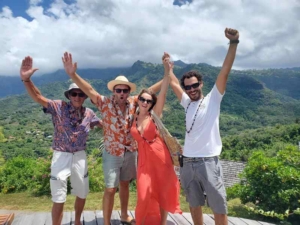 At 06:30, we dropped anchor just outside the main part of the bay—it’s pretty crowded here.
At 06:30, we dropped anchor just outside the main part of the bay—it’s pretty crowded here.
We logged a total of 3,028 nautical miles in 378 hours, averaging 8 knots SOG. Not bad at all.
That last day and night at sea was a mixed bag. By late morning the wind had picked up again, and for the first time on this crossing it actually shifted fully to the east. That meant we had to sail dead downwind—not exactly our favorite course to sail.
But we also wanted to make landfall during daylight, so we had to keep the speed down. In that sense, gybing back and forth to slow down a bit worked out perfectly.
After the first gybe, you really notice how used you get to sailing on a single tack (starboard, in this case). Suddenly doors swing open instead of closing, and things fall off shelves that had stayed in place for days.
During my last night watch, I counted around 25 wind shifts, with the wind bouncing between 7 and 17 knots. I had to steer up to keep pressure in the sails, then bare off again to avoid heading too far south.
When Miguel came to take over, we just dropped the sails and motored the final stretch.
The rest of the day was mostly relaxing and clearing customs. We thought we’d go out for dinner somewhere, but in the end, that didn’t happen. Once you’re at anchor, you suddenly feel just how exhausted you are. And that’s okay—finally a night with no alarms!
It all went by so fast. Not just in terms of time (we arrived nearly a week earlier than last year), but also in how it felt. The vibe and the way everyone got along was truly special—kind, helpful, relaxed, and just happy to be here, and with each other.
Tuesday, March 26th, exploring Hiva Oa
The past few days have mostly been about catching up on sleep, cleaning the boat, and tackling some repairs.
Even though the crossing went quickly, you still end up running on fragmented sleep—just enough to get by, but not enough to feel rested.
Sunday turned into a proper “day off”—we did absolutely nothing. But yesterday and today we were back at it. On the one hand, we deep-cleaned the boat. On the other, we had to fix a burnt charging conductor —most likely a result of faulty installation by the yard. The fuses had been mounted using stainless steel washers and nuts between the fuse and the conductor, which creates too much resistance. Not a big deal with low currents, but with 100 amps running through? Things get hot fast. Anyway, I checked all the connections and ended up adjusting most of them.
The engine also wasn’t running well—it struggled to start sometimes. We replaced all the filters and swapped out the lift pump, and after that, it purred like a kitten again.
Next up is the freezer. It’s not really working anymore—there’s likely not enough gas in the compressor. Someone’s supposed to come by tomorrow to take a look.
Also tomorrow, hopefully, our laundry comes back. It was supposed to be ready Monday, but a local power outage changed those plans…
Of course, we’ve been ashore as well. Had a great meal at Mokai O Mango and another one at Hanakee Lodge. Funny thing—at the lodge, my phone immediately connected to the WiFi. It still remembered the password from last year.
Marc and Caroline booked an Airbnb for three nights—a little time off together, just the two of them.
The plan is to sail back to Fatu Hiva on Thursday. It’s still one of the most beautiful islands in the Marquesas.
Late this afternoon, we suddenly got called on the VHF. A boat was approaching and asked if there was still room to anchor inside the bay. Turned out to be Loveworkx, a 28-foot boat with a shallow draft—plenty of room for her!
From the skipper’s accent, I immediately guessed she was Dutch. Jacqueline Evers—she’s doing a three-year solo circumnavigation. Funny thing: I later realized I’ve been following her on Facebook for a while.
Miguel helped her out a bit from the dinghy, and now she’s anchored right next to us.
Friday, March 29th
Over the past few days, Miguel and I have tackled all kinds of jobs on the boat. We get along really well, and it’s been fun working together.
On Wednesday, we invited Jacqueline over for dinner. It was super gezellig. The supermarket had already closed, so I had to improvise: spaghetti with tuna sauce. Luckily, the sauce turned out great, and everyone loved it.
Thursday morning I helped her out with some things on her boat. The gooseneck fitting had come loose, but a bit of Loctite sorted that out. Her vang had also detached from the mast. Someone had tried to fix it earlier but hadn’t done a great job—all the rivets had snapped. That repair took more time, but with some epoxy and new rivets, we got it sorted. And then there was the spinnaker pole—it wouldn’t open on one end. Turned out it was just salt and grime.
When Marc and Caroline came back aboard. They had decided to let Miguiel go. Things had been a bit tense the last part of the trip. Anyway Miguele packed his stuff, left the boat, and spent the night on Jacqueline’s.
He’s since found another boat and will now be working there as skipper.
Monday, April 1st, Hanamoenoa Bay, Tahuata
Later that Friday, we moved on to Hanamoenoa Bay on Tahuata, a small island about 10 nautical miles from Hiva Oa. Not really far enough to bother hoisting the sails—and besides, there was hardly any wind.
Hanamoenoa is a stunning bay, complete with a sandy beach and palm trees. But other than that, there’s nothing there. Getting ashore with the dinghy was… let’s say, adventurous. It was high tide, and the surf was living up to its name.
We ended up anchoring about 20 meters from the shore, and for the last stretch we had to swim in from the dinghy.
Several other ARC boats were anchored in the bay, and that evening we all had cocktails on the beach. Paddleboards turned out to be the best way to get gear ashore, though not without mishaps—our shrimp (meant for a salad) decided to rejoin the ocean. Oh well. It didn’t ruin the fun—we had a great time.
What was less fun: our freezer officially gave up. It had been struggling for a few days already. Back in Hiva Oa, we had the compressor refilled with gas, and that initially seemed to help, but soon after it stopped cooling altogether.
Thankfully, we were able to store the contents on another boat for the time being. We’re hoping to have it properly repaired in Nuku Hiva. Marc has a spare compressor on board, so if needed, we can just have it replaced.
The next day brought a bit of a shuffle—some boats left for Ua Pou or Nuku Hiva, while others arrived, including Navilus. On our way back from the beach, we swung by to say hi, and of course, we were immediately invited aboard.
Naturally, “just stopping by” turned into a full visit, which then turned into a lunch invitation: they’d come over to our boat on Sunday—Easter Sunday—for lunch.
The lunch turned out great, thanks to Caroline’s cooking skills. She’s really good at it and clearly enjoys it too.
While she was busy in the galley, Marc and I replaced the generator filters and ticked off a few other engine room jobs. All in all, it was a productive and successful day.
Today we’re leaving for Nuku Hiva—about 99 nautical miles from here. There’s basically no wind, so we’ll probably be motoring the entire way. Oh well, can’t win ’em all.
Navilus, on the other hand, has water in both saildrives and can barely use their engines. They’re a 50ft Lagoon catamaran, and with just 5–6 knots of wind, they struggle to hit even 2 knots SOG. So they’ll likely take a bit longer than our estimated 20 hours.
Tuesday, April 2nd, Nuku Hiva
We arrived in Nuku Hiva early this morning. The crossing from Tahuata took just under 20 hours, almost entirely under motor as expected—there was barely a breath of wind. We had a smooth trip though, calm seas and a star-filled night sky. Not much to complain about.
Coming into Taiohae Bay felt almost like arriving in a bustling metropolis after the quiet anchorages of the past few days. Lots of boats here, plenty of movement, and a small town that actually has shops, cafes, and even some infrastructure.
The plan for today is mostly practical stuff: clearing in properly, doing a provisioning run, and checking if we can finally sort out the freezer. Marc is hoping we can find someone here who can either repair it or swap out the compressor with the spare one we’ve got on board.
One of the first things we noticed after dropping anchor: the internet! It’s far from perfect, but after days of silence, even a slow connection feels like a small miracle.
We ran into several familiar boats from the ARC fleet—some we hadn’t seen in weeks. It’s funny how quickly a sense of community builds on a trip like this. Everyone’s got stories, breakdowns, and victories to share.
We’re planning to spend a few days here. It’s a good place to restock, fix what needs fixing, and prepare for the next leg of the journey. Also, a little breathing space will probably do the crew dynamic some good after the tensions of last week.
This evening we’re going to grab dinner in town—there’s a little place a few people have recommended. If all goes well, maybe we’ll finally have something other than spaghetti with tuna sauce…
Saturday April 6th, departure for Makemo
The past few days were all about fixing the freezer and doing nothing.
Well, not exactly nothing. I woke up around 6 AM every day, which gave me some time for myself—coffee, breakfast, and some messages or calls with Marischka. By 7 AM, I was getting started with small tasks and repairs.
Mike helped us a lot with fixing the freezer. He’s here with his girlfriend on their boat, but before that, he spent 30 years in the refrigeration and freezer industry. He regularly helps out on boats and is listed in the Tahiti Cruiser Guide.
The problem turned out to be more than just refilling gas. The controller wasn’t working correctly, and later we discovered the pressure switch was also faulty. We could easily replace the controller because Marc had a complete unit as a spare. For the pressure switch, we bypassed it for now. Marc will replace it with a heavier-duty switch when we get to Tahiti. Anyway, the freezer works perfectly now, and we could finally store our stuff that other boats had been keeping for us.
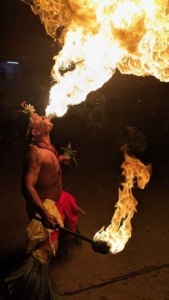 Last Wednesday, there was the prize-giving for the crossing to the Marquesas with a local buffet, dance, and music. It was nice, but I was less impressed than last year.
Last Wednesday, there was the prize-giving for the crossing to the Marquesas with a local buffet, dance, and music. It was nice, but I was less impressed than last year.
In that sense, it’s good to be on the move again. We’ve had a nice 15-knot wind on the beam, which is giving us 7.5-8 knots SOG. It’s a 500 Nm trip to Makemo. If the forecast holds, we should be there in 3 days.
Monday April 8th, position 12:46.308S 142:02.818W
We’re doing well! We now have around 20 knots of wind, and with full sails (and a full ballast tank), we’re averaging 8-9 knots SOG. If we can maintain this speed, we should arrive by tomorrow morning.
The past two days were a bit slower, and until last night, it seemed like we might need to slow down to avoid arriving in the dark.
The first night at sea was pretty squally, at least during my watch from 00:00 to 04:00. When my watch started, it was clear, but I had to furl the genoa a few times during squalls. During the gusts, we had about 30 knots, which is a bit much with full sails. When Caroline took over from me, it was calm and clear again.
The second night was similar, but instead of furling the genoa, I filled the ballast tank halfway, and that worked fine.
Fishing was also good. On the first afternoon, we caught a big Mahi Mahi, and the next day, we caught a nice tuna. Between 16:30 and 17:00 seems to be the best time for bites. We get a catch within half an hour.
Filleting the fish is getting easier. Well, I just cut the fillets out. I leave the head and innards, as that makes a mess, and we also give some back to the other fish.
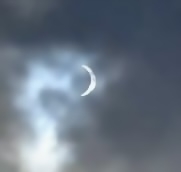 This morning around 06:30, there was a partial solar eclipse. With my sunglasses and the flag, I could see it fairly well, but it was too bright for a photo or video. Jayne on Dilema got a good
This morning around 06:30, there was a partial solar eclipse. With my sunglasses and the flag, I could see it fairly well, but it was too bright for a photo or video. Jayne on Dilema got a good
picture through the sextant lens. I didn’t have mine with me.
Tuesday, April 9, Makemo
We kept a good wind of 15-18 knots on the beam and a corresponding speed. We arrived just before 12:30 at the pass, right at high tide.
With a 3-knot current pushing us, we passed through the Tapuhiria Pass, even though water was still flowing out along the channel.
Anchoring went smoothly, and after lunch and a short siesta, we went ashore for a brief walk. Caroline had badly bruised or maybe even broken her little toe, so after one lap, she decided to rest.
During our walk, we passed the “restaurant” where we had planned to eat, and we also stopped by Beko, where I had bought pearls for Marischka and all the daughters, including my daughter-in-law, last year. I wanted to get another one for Andrea, my daughter-in-law who wasn’t with us last year.
Beko was out of pearls and would return the next morning. That’s still a bit of a cliffhanger.
Late in the afternoon, just before dark, we went ashore for dinner. It was a challenge because Caroline wasn’t walking well, so we had to anchor at a different spot. We had to navigate between reefs and bommies.
The restaurant was very local, simple in setup and décor. They had three dishes on the menu, and without ordering, we were served exactly what we would have ordered, with the right dishes delivered to the right person.
The return trip with the dinghy was a bit more challenging since it was pitch dark by then. We went slowly, and everything went fine. By then, the day was over, and we went to bed on time.
Thursday April 11th, Fakarava South Pass
Beko wasn’t home the next morning either. From what I understood, he wouldn’t be back until the following day… And if I understood his son correctly, he had stopped his pearl business. Well, I’ll just have to look for another place to shop.
That afternoon, we set sail for Fakarava, which is about 120 Nm away. A depression was expected to bring strong winds and waves over 3 meters, so we thought it would be better to be in the shelter of a lagoon. Staying another 2-3 days in Makemo didn’t seem appealing. Fakarava offers better diving, snorkeling, and several nice anchorages.
The trip to Fakarava was calm. It was a broad reach, and we only had the genoa out. Depending on how the wind behaved, we might have set the mainsail, but the wind stayed at the same angle, so we sailed the entire way with just the genoa.
That was fine because we didn’t want to go too fast. The plan was to arrive around 13:00 and enter with the rising tide. The timing worked perfectly, and we anchored by 14:30.
In the late afternoon, we went ashore for a sundowner with some other boats. It was also a good spot to watch how quickly the water flows in.
That evening, I went to bed very early. I had never felt so tired. As soon as my head hit the pillow, I was asleep. I guess I was just really worn out.
That night, I woke up at some point. By then, the wind had picked up to nearly 30 knots. The anchor held well, so I could go back to sleep peacefully.
Monday April 15th, Fakarava North Pass
We stayed at the South Pass for two nights. The wind kept blowing quite strongly. The depression that passed over was huge, with a lot of wind and rain.
On Friday, we managed to do some great snorkeling during the clear spells. Marc had booked a dive for Saturday, but it was canceled in the end. We decided to head north on Sunday morning to Rotova, the village by the north pass. There’s more to do there, and the weather was expected to calm down starting Monday. The north pass is also a great spot for diving.
The watermaker was still leaking, and Marc and I spent almost the entire day working on it. We took it out and put it back in at least four times, each time trying a different method to fix the leaking coupling. It got worse before it got better, and eventually, we were happy to have it to the point where it was only leaking a little.
The north pass is about 30 Nm away, and the route goes through a well-marked channel. The wind hadn’t died down, so we made it there in about five hours with just the genoa.
The last part wasn’t entirely smooth. Someone had laid his pearl lines across the channel, and I didn’t see the buoys in time—they were all dirty and covered in seaweed. We got stuck in the middle of the channel. We didn’t want to start the engine for fear of the line getting caught in the propeller, so the only option was to cut the line. It was quick, and we were free again. Too bad about the line, but that’s the risk of having nets across the channel.
That evening, we went out for dinner at the only restaurant that’s open on Sundays. It was really nice, until we had to return to the boat. It had started raining in the typical tropical way, a torrential downpour that didn’t stop. Eventually, we just walked back. Once you’re wet, there’s no point in worrying about it anymore.
The rain continued all night, and when I woke up this morning, the sky was completely gray, and it was still raining. I’ve never seen it rain like this here before. It can rain for days back home, but it’s quite unusual here. Well, I guess it will stop eventually. The wind has died down now, though.
Thursday, April 19, still at Fakarava North Pass
The last few days have been a bit dull. Monday and Tuesday were almost entirely rainy. The sky was gray, and the air felt a bit like back home in the Netherlands. The temperature was still tropical, but the boat was uncomfortable. With all the hatches closed due to the rain, the heat inside was stifling.
The locals, however, were happy for the rain. It’s their only source of fresh water, besides bottled water.
Because of the rain, my snorkeling plans fell through. You don’t notice the rain much when you’re diving, but it makes snorkeling a bit harder. Besides, the visibility was much poorer.
What was great, though, was that I managed to get a pearl for Andrea, a personalized one. Of course, there’s a pearl shop here. They didn’t have any engraved pearls, but the shop owner’s friend did. She lived close by, so I sat down to wait a bit. In half an hour, she arrived on her bike with exactly the pearl I was looking for. It could have come from Beko.
Later that day, we finally managed to fix the watermaker. All the couplings were now leak-free, and we could use it again without needing towels and bowls to catch the leaks.
By Wednesday, the weather had cleared up. Apart from a few showers, the sun was shining again, and I finally went snorkeling. Caroline stayed behind to paint, and Marc had a dive booked.
That evening, the supply ship finally arrived. It had been days since the gas station was closed… and out of stock. Eggs, fresh fruit, and vegetables had also been unavailable at the supermarket for some time.
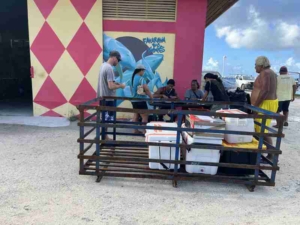 We were there early in the morning. Too early, though—the dock was still full of pallets that needed to be unpacked. A long line of cars was already waiting at the gas station.
We were there early in the morning. Too early, though—the dock was still full of pallets that needed to be unpacked. A long line of cars was already waiting at the gas station.
Later, at 10:00, we were too late for eggs, but we did manage to get some fruit and vegetables. We didn’t need much, though. Tomorrow, we’re sailing on to Rangiroa. We’ll see what happens next.
Sunday April 21sy, on my way home
The trip from Fakarava to Rangiroa was my last trip of this journey. We arrived on Saturday morning. When we anchored, I could start gathering my things bit by bit.
Later in the day, we went ashore and walked to the restaurant by the pass. It’s always impressive to watch the water first rush in and then, against the wind, flow back out.
That evening, we ate at the pizza place I remembered from last year. Last time, I got a Hawaiian pizza without pineapple because they were out. This time, everything went smoothly, and the pizza was excellent.
I was planning to take the dinghy to the airport, but the weather looked a bit threatening. We decided to have lunch at the resort where we were anchored and take my things with me, just in case I had to take a taxi instead.
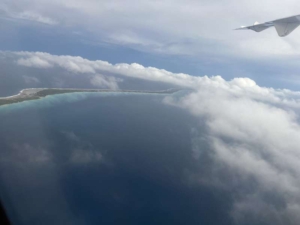 That turned out to be a good idea. The weather got so bad that I was worried my flight to Papeete might be canceled. Thankfully, it wasn’t, and a few hours later, I was checked into the airport hotel in Papeete.
That turned out to be a good idea. The weather got so bad that I was worried my flight to Papeete might be canceled. Thankfully, it wasn’t, and a few hours later, I was checked into the airport hotel in Papeete.
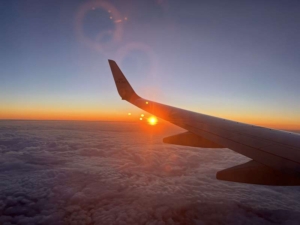 The next morning, the long journey home began. First, a 6-hour flight to Los Angeles, then 11 hours to Paris, and finally the last leg to Amsterdam. Well, I was on the other side of the world with a 12-hour time difference.
The next morning, the long journey home began. First, a 6-hour flight to Los Angeles, then 11 hours to Paris, and finally the last leg to Amsterdam. Well, I was on the other side of the world with a 12-hour time difference.
